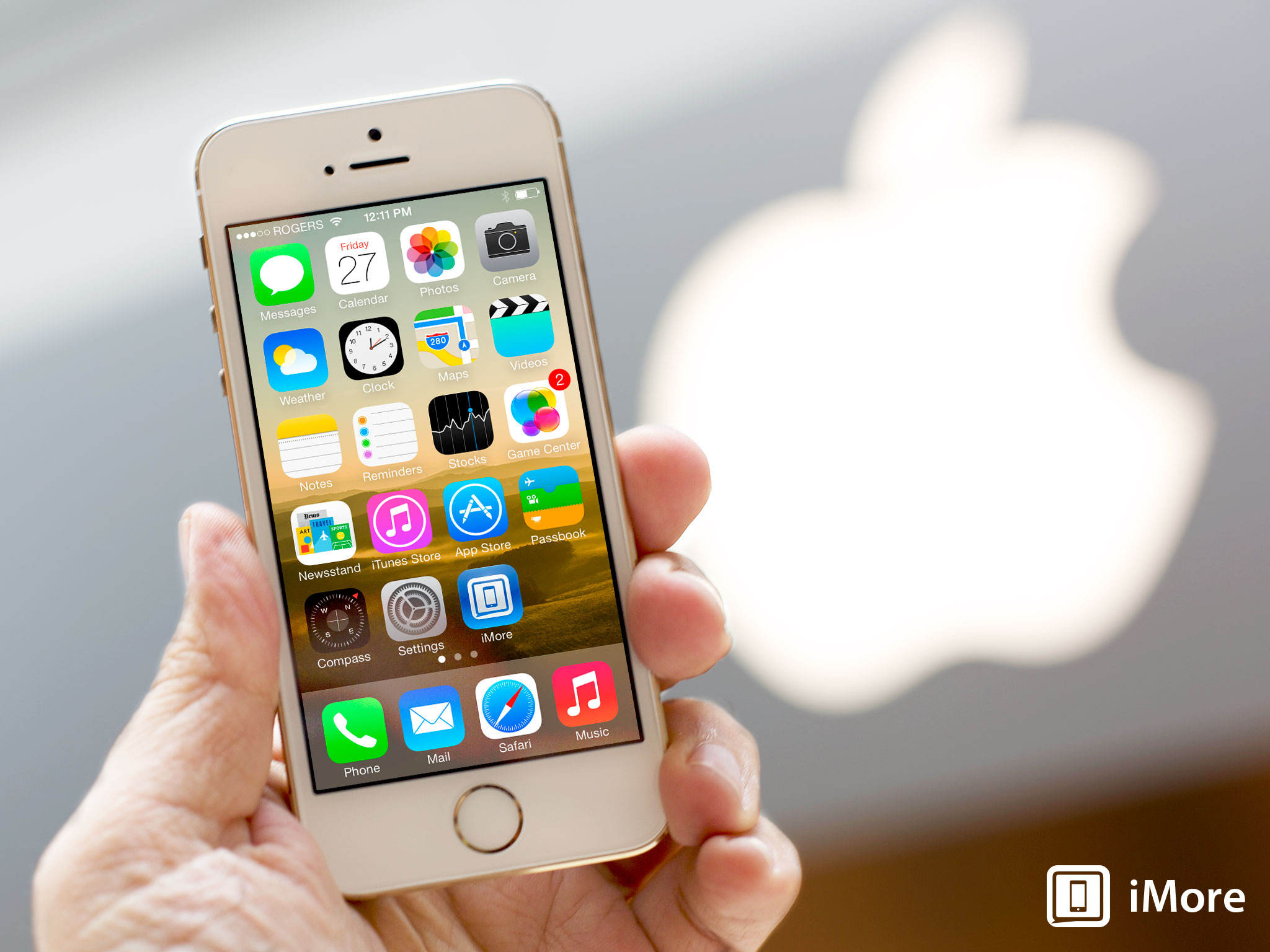Every tick has its tock. Every leap forward in design, a follow up in performance, and optics, and special features. Every new iPhone, its S-class successor. That was the story of the iPhone 3GS in 2009 with its speed doubling, video recording, and voice control. Of the iPhone 4S in 2011, with its dual-cores, 1080p, and Siri. And its the story of the iPhone 5s in 2013, with its 64-bits, 120 frames-per-second, and its fingerprint ID sensor. It's the story of taking what is and making it into what's next. Of recognizing most revolutions don't happen during the span of a single keynote, but rather as the result of steady, steadfast innovation, iteration, and improvement.
The iPhone 5s is the new flagship phone from Apple. Like the iPhone 3GS and iPhone 4S, the iPhone 5s retains not only the same name, but the same design and many of the same features as its most immediate predecessor. Unlike any iPhone before it, however, the iPhone 5s doesn't get to be all new, all by itself. Not this year. This year it has to share the stage - and the shelves - with the far more colorful, arguably more fun, iPhone 5c. In a time when competition has never been stronger, the iPhone 5s is facing it even from Apple. Yet being the top-of-the-line iPhone has never been about total cost or popular appeal. It's been about being the top-of-the-line iPhone. It's been about giving us what Apple calls their most forward-thinking iPhone ever, in our hands, now, today. But now, today, is it forward thinking enough?
iPhone evolution
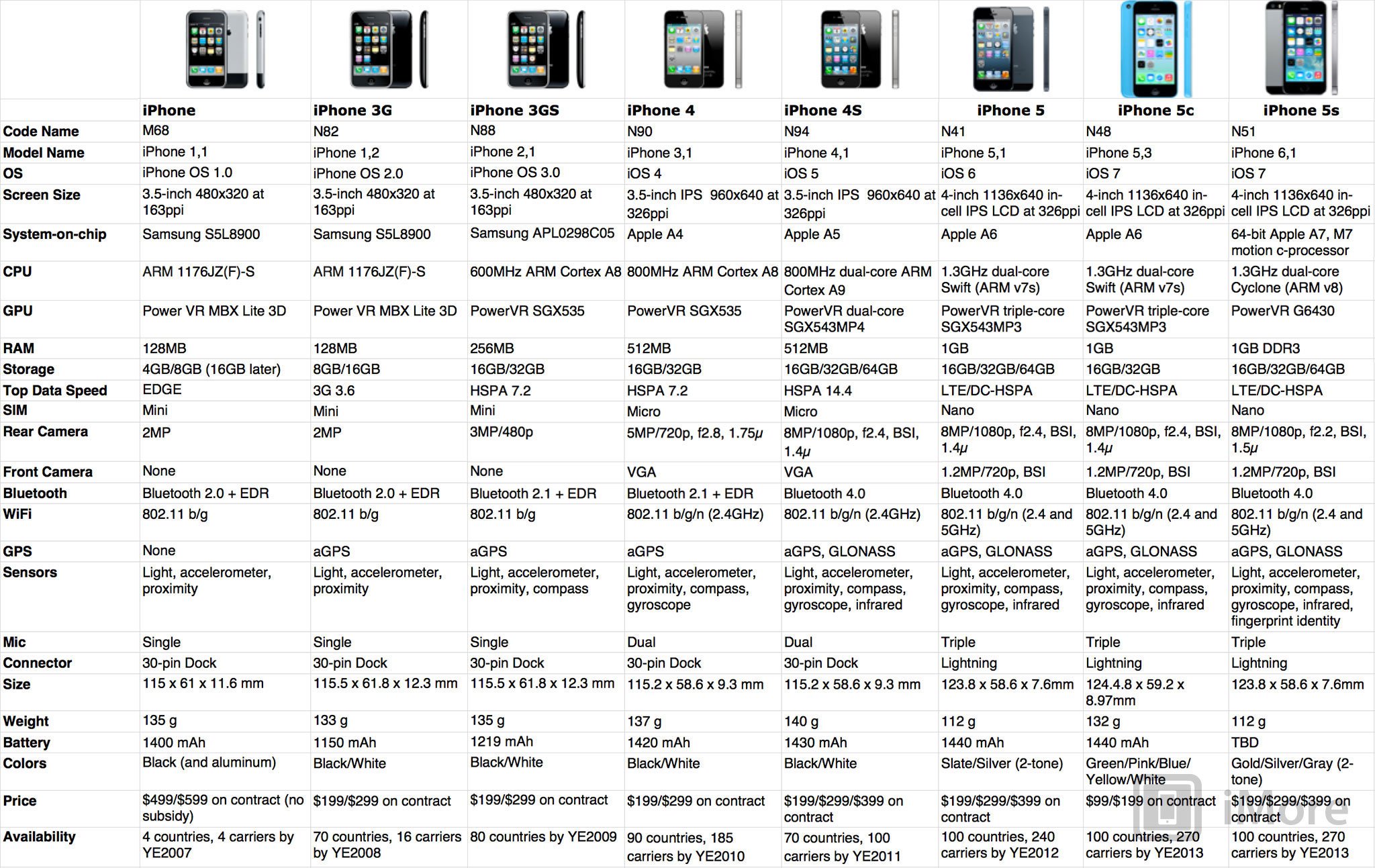
Every iPhone stands on the shoulders of the iPhones that came before it. As the old saying goes - can't know where you're going if you don't know where you've been. This is where the iPhone has been, and along with everything Apple is packing into the iPhone 5s, it's as good a sign as any of where they're going.
- iPhone 5 review (September 2012)
- iPhone 4S review (October 2011)
- iPhone 4 Review (June 2010)
- iPhone 3GS review (June 2009)
- iPhone 3G review (June 2008)
iPhone 5s packaging
The iPhone 5s comes in the same style of box Apple's been using since they introduced the product. The boxes are all white, but the color of the phone - black or white - and the two white trims - silver or gold - are reflected by the image on top.
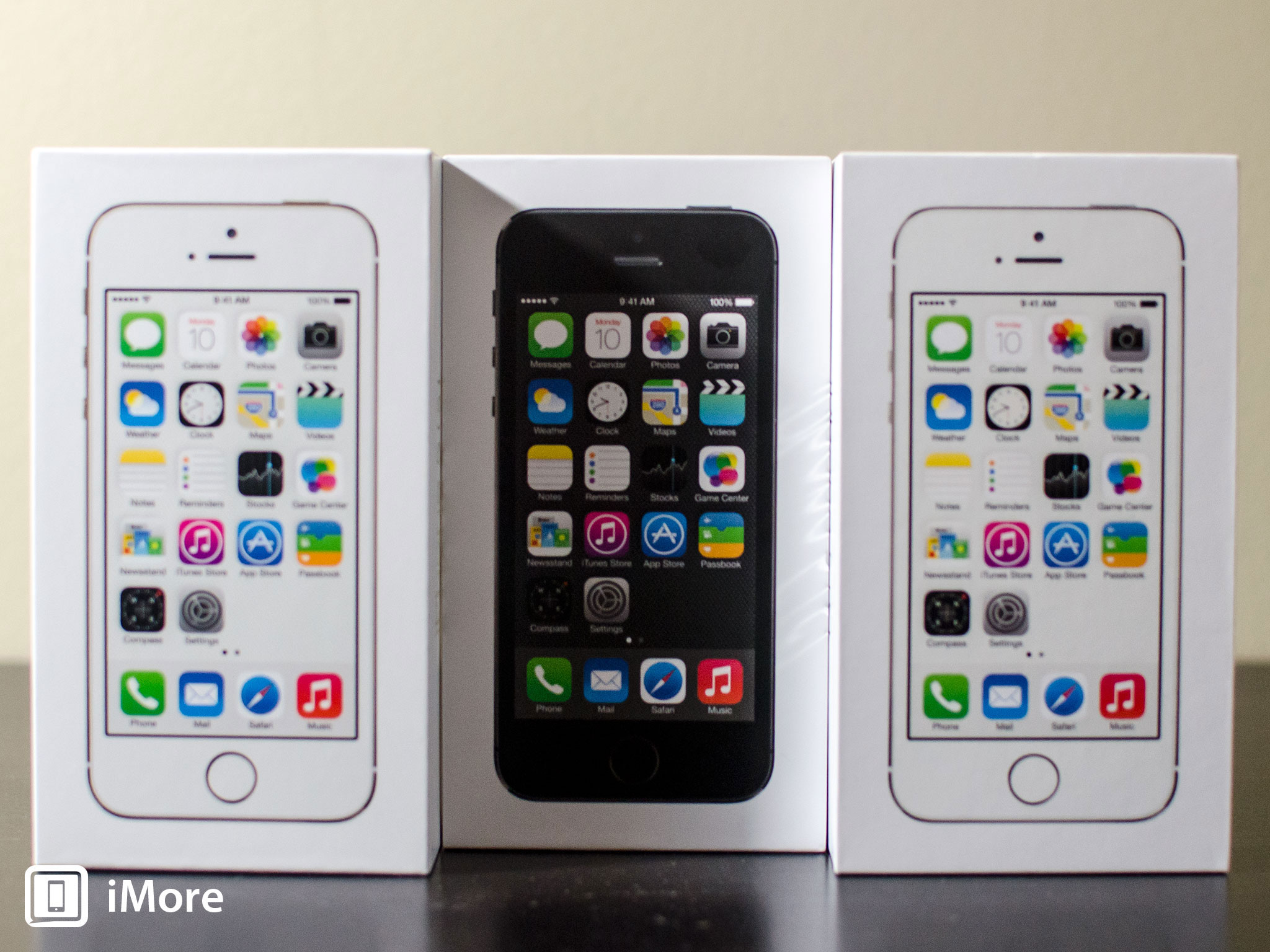
Inside are the usual accompaniments; a Lightning cable and AC adapter, a pair of EarPods and Apple's booklets.
iPhone 5s design and the gold standard
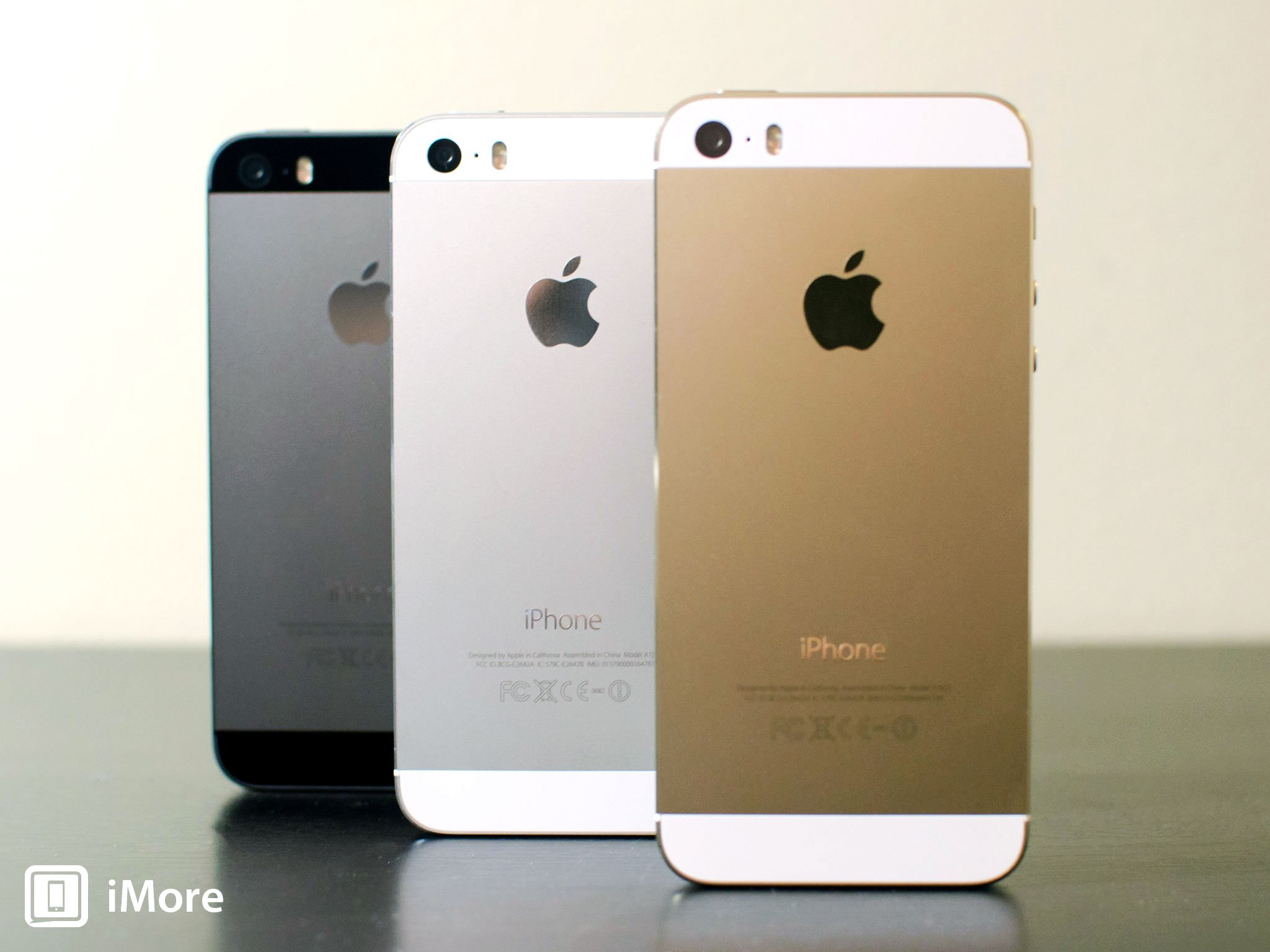
The 2013 iPhone 5s looks almost identical to the 2012 iPhone 5. What external differences there are come down to the new True Tone flash, and Touch ID's inclusion in the Home button. There's now an oval on the back to make room for the dual LED, one white the other yellow, and the rounded rectangle icon on the Home button is gone so that nothing obstructs the fingerprint sensor.
Otherwise, the 4-inch, 1136x640 pixel, 16:9 aspect ratio, 326ppi LED backlit, in-plane switching (IPS), in-cell display remains as gorgeous as ever, presenting text and images as though they're painted into the glass. (If you were hoping for a bigger screen, next year might prove more interesting for you. Likewise, the manufacturing, from lightly textured aluminium unibody with diamond polished chamfered edges to photo-matched glass inserts, remains as perfectly assembled as ever, thin and light to the point where it seems almost unreal.
Keeping the same design for two years running is nothing new to Apple. The 2011 iPhone 4S looked almost identical to the 2010 iPhone 4, and the 2009 iPhone 3GS looked almost identical to the 2008 iPhone 3G.
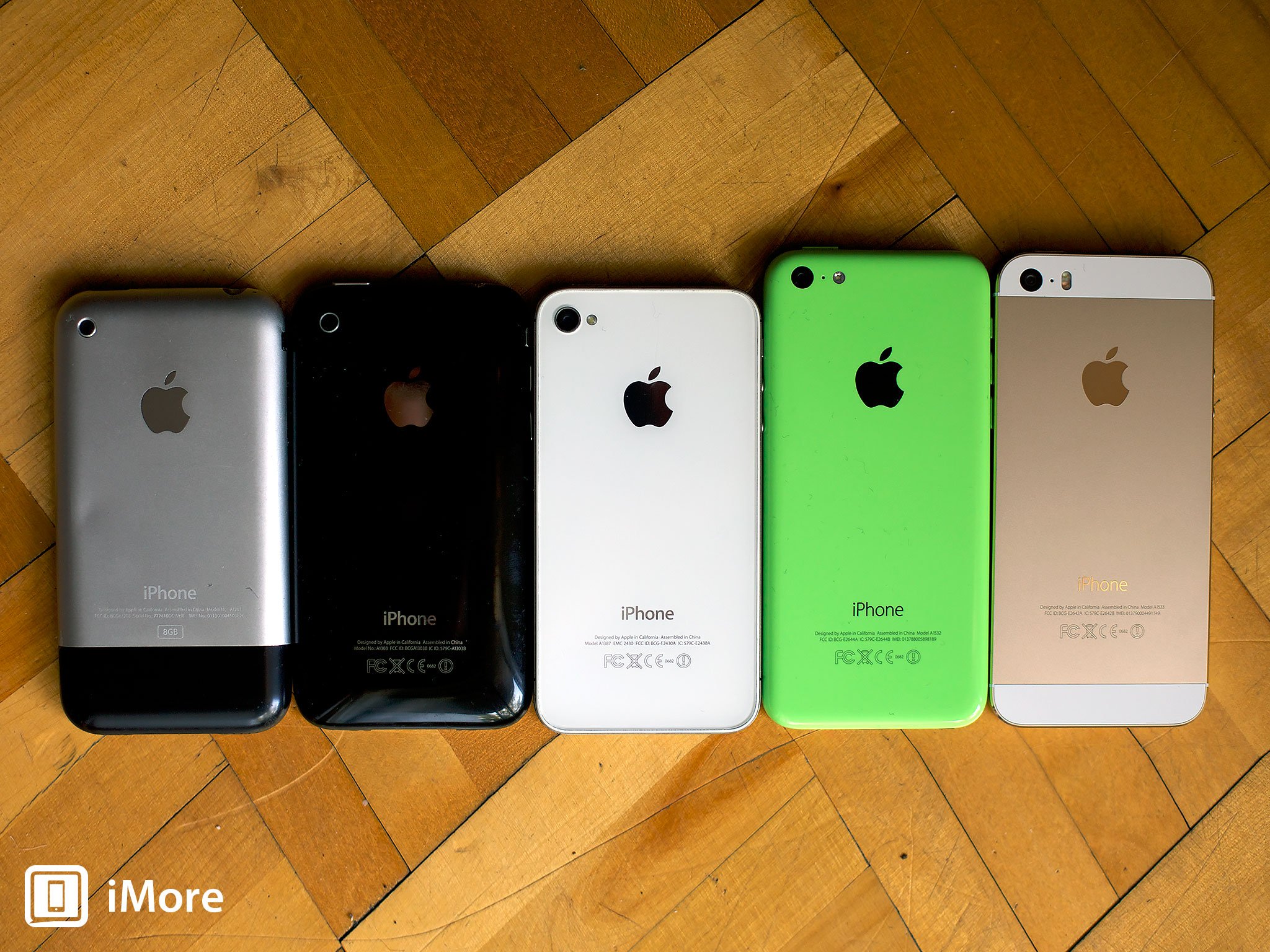
It's what Apple does. It's what a lot of companies do. It offers huge advantages to the company in terms of product management and manufacturing, and huge advantages to the consumer in terms of accessory compatibility. But, boring. That's the accusation anyway, and the perception. And perception is reality.
It was also the accusation and perception last year, when Apple rebuilt the iPhone 5 from very nearly the atom on up, just to be told it was unimaginative and uninspired. A taller 4-inch screen didn't matter. Faster LTE networking didn't matter. More advanced Lightning connectors not only didn't matter, but infuriated some people. The new, custom processor, the improved camera, none of them mattered to people who were looking for a bigger, more superficial change.
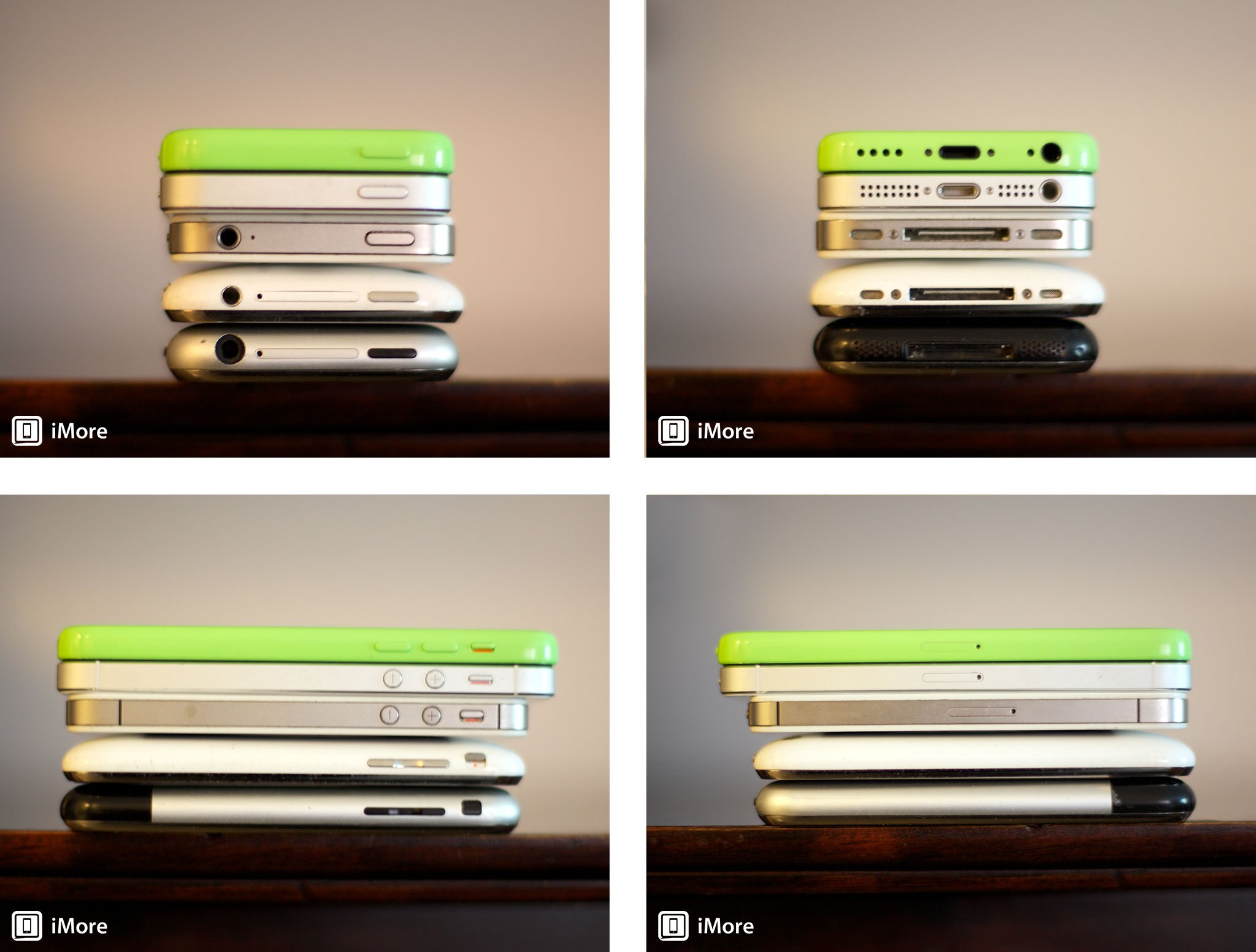
So, facing another S-year, and unprecedented competition, what could Apple do? Give people just exactly the kind of superficial change they'd been demanding.
The original iPhone was aluminum and black, much like all professional level Macs have been aluminum and only aluminum for over a decade. Subsequent iPhones have been black and white, with various polycarbonate, stainless steel, glass, and aluminum materials and treatments thrown in both for design and function. Color, until this year, was reserved for the even more mainstream, more pop-culture iPod line. And while Apple didn't take the iPhone 5s to the same multi-chromatic levels they took its mid-tier sibling, the iPhone 5c, they expand its palette, by just one, and for the first time ever.
Enter gold.
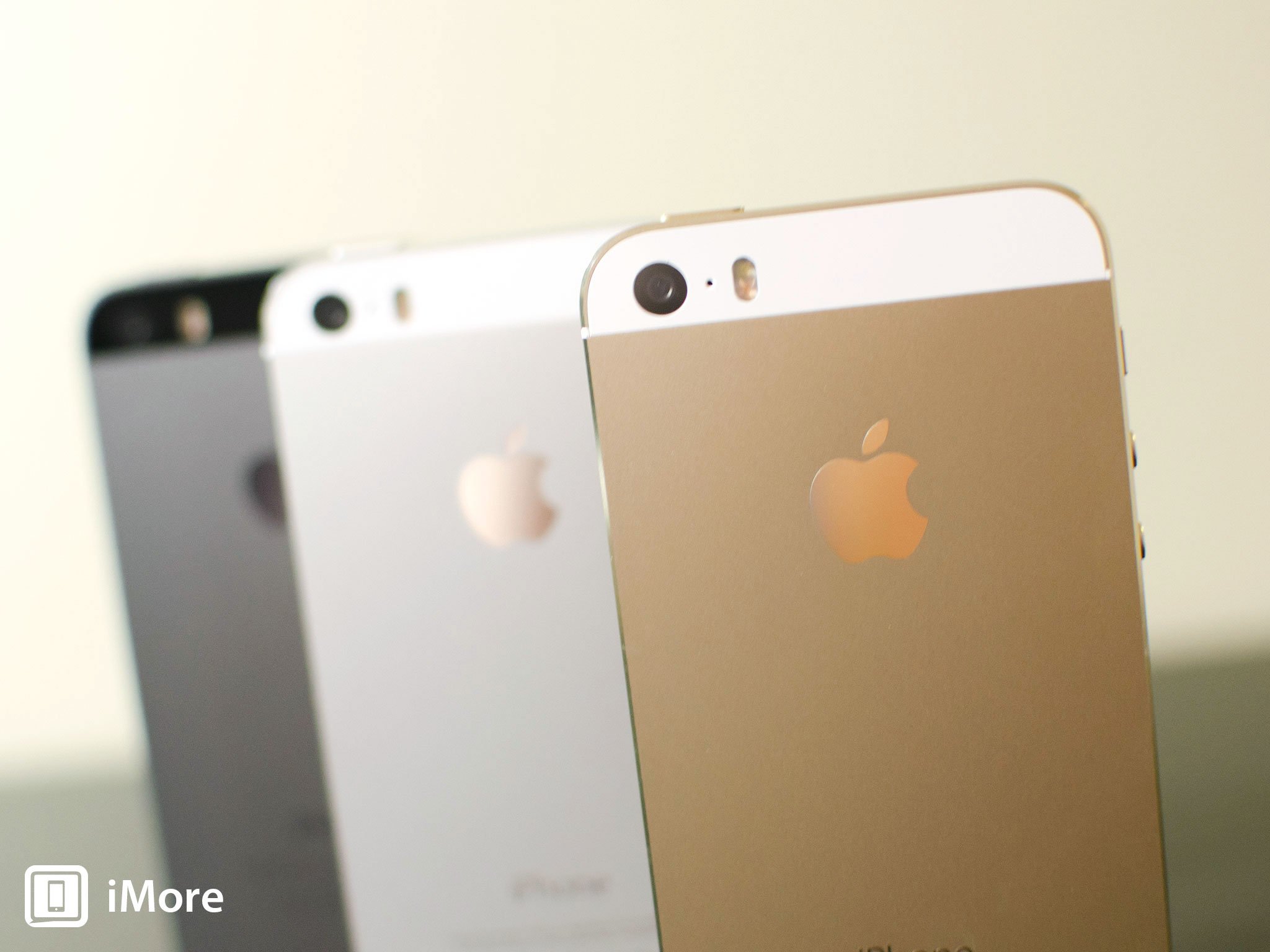
One of the easiest colors to manufacture, Gold has also been the most popular aftermarket color for the iPhone 5. In North America it was glitzy, in Asia, a symbol of prosperity. It also fit with Apple's existing metallic theme for their high-end products.
Not a deep gold, mind you, but a pale one more reminiscent of champagne and set against the same white faceplate and back RF windows that were used last year, and are still used this year, for the silver finish. Because last year's black model proved so susceptible to scratches and chips, Apple also ditched the very hard to anodize slate color for a much easier "space gray" finish. (That's apparently the politically correct - and decidedly more sci-fi - term for gunmetal gray.)
And if you think Steve Jobs would never have done these finishes, boy do I have some gold iPods, and Blue Dalmatian and Flower Power iMacs to show you...
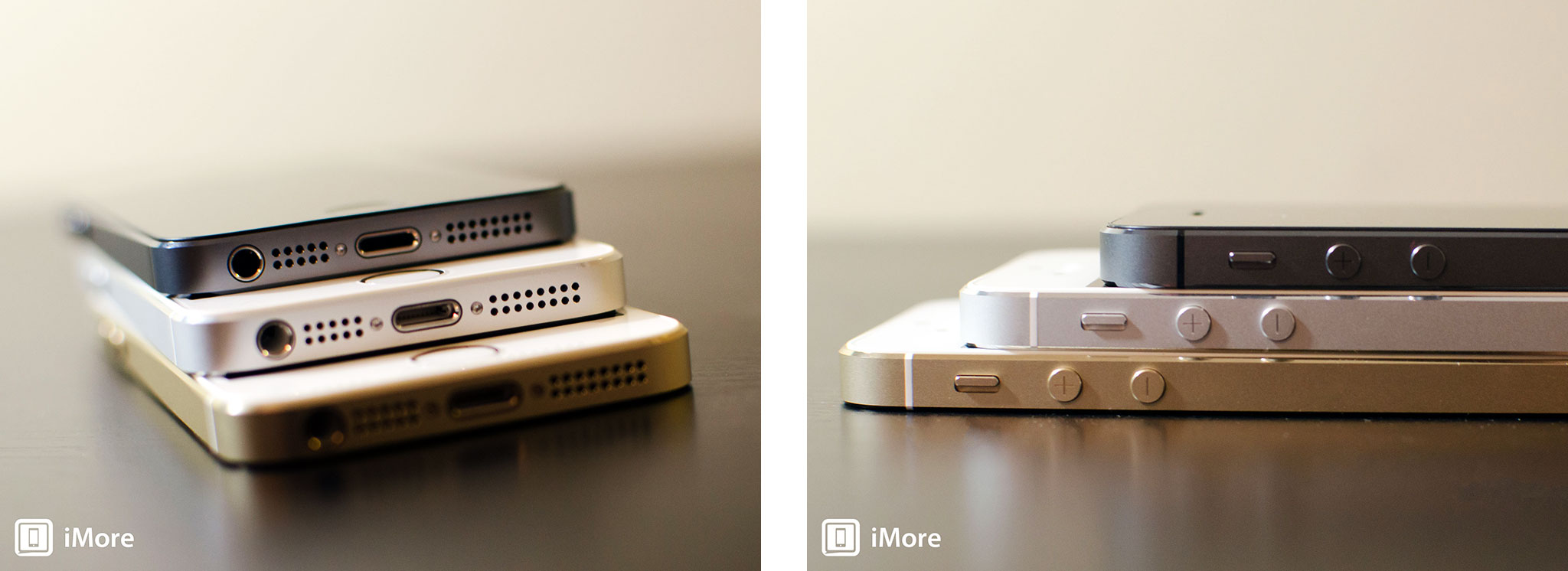
I have a silver iPhone 5, and I used the space gray iPhone 5s briefly before switching to the gold one, which I'll be using going forward. They all look great, and the space gray especially looks and feels more resilient than the slate model last year.
So, Apple gets to keep their two-year design cycle, focus on the internal improvements they'd be focusing on anyway, and people who want to show off that they have the latest, greatest iPhone get a glamorous new gold color that lets them do just that.
Apple A7 64-bit performance and battery life
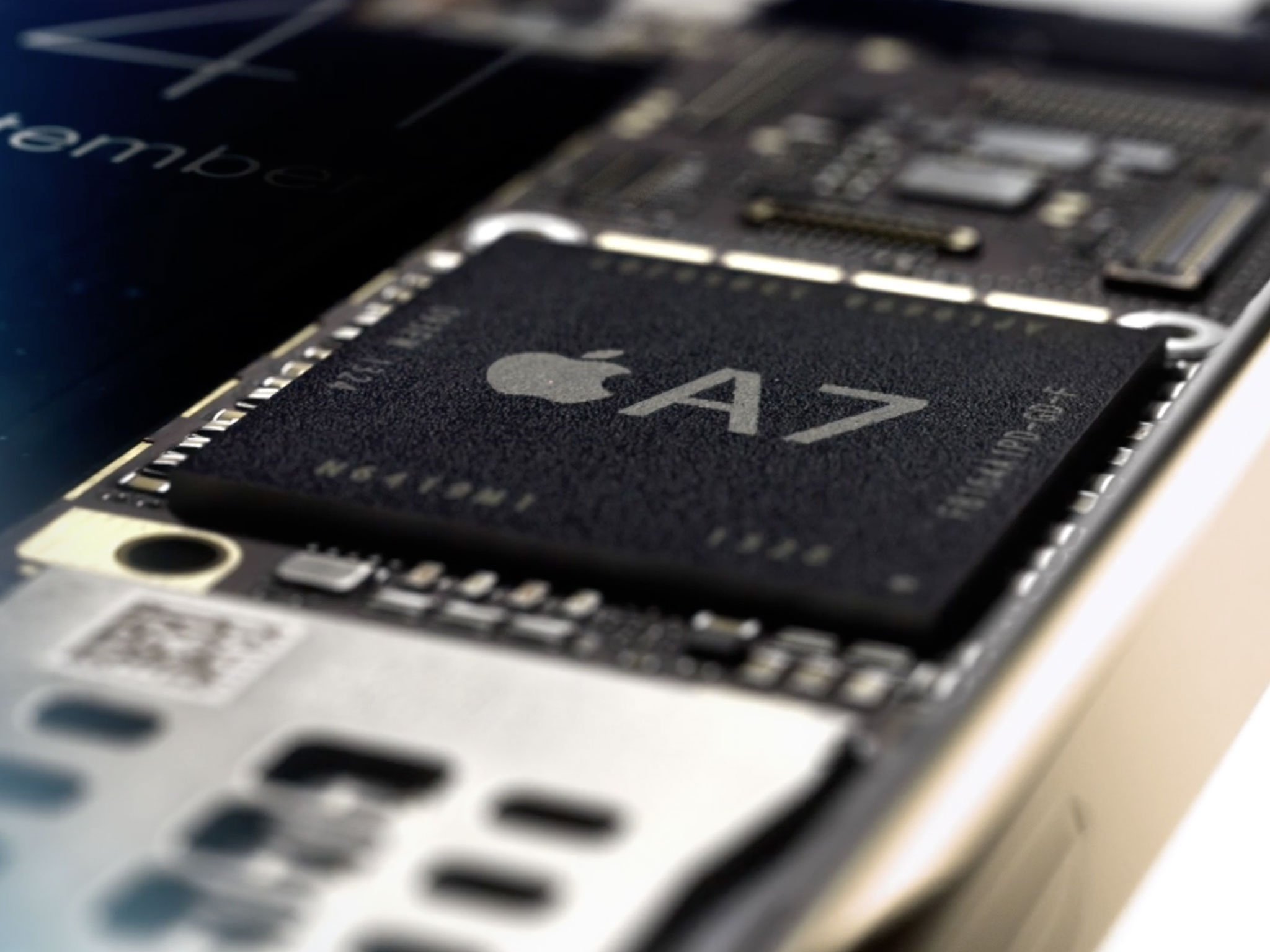
The Apple A7 system-on-a-chip (SoC) is at the heart of every iPhone 5s. Apple says the A7 is twice as fast at both general purpose and graphics processing as its predecessor, the A6, yet it remains roughly the same size. More interestingly, the A7 is 64-bit - the first 64-bit processor crafted for a consumer smartphone - and it supports OpenGL ES 3.0.
Apple began designing their own chipsets in 2010, licensing the ARM Cortex A8 for the Apple A4. In 2013, Apple switched from licensing a chip to licensing an instructions set architecture (ISA), ARMv7, so they could create their own custom chip, the Apple A6. The CPU was codenamed Swift. It was a 32nm CMOS dual-core Apple processor clocked up to 1.3GHz and they paired it with a triple-core PowerVR SGX543MP3 GPU and 1GB of DDR2 RAM.
Now, with the iPhone 5s, Apple has created their second generation custom CPU, this time codenamed Cyclone. Anandtech sleuthed out the name and deduced many of its likely details. Cyclone is 28nm now, still dual-core and 1.3GHz, but based on the new 64-bit ARMv8 ISA. It's paired with an OpenGL 3.0 capable PowerVR Series 6 (Rogue) graphics processor, potentially the G6430, and 1GB of DDR 3 RAM.
Here are the usual benchmarks, just to put some numbers to the hyperbole. In order, iPhone 5s, iPhone 5c, and iPhone 5 results on Geekbench (CPU), SunSpider (JavaScript), and GFXBench (GPU):
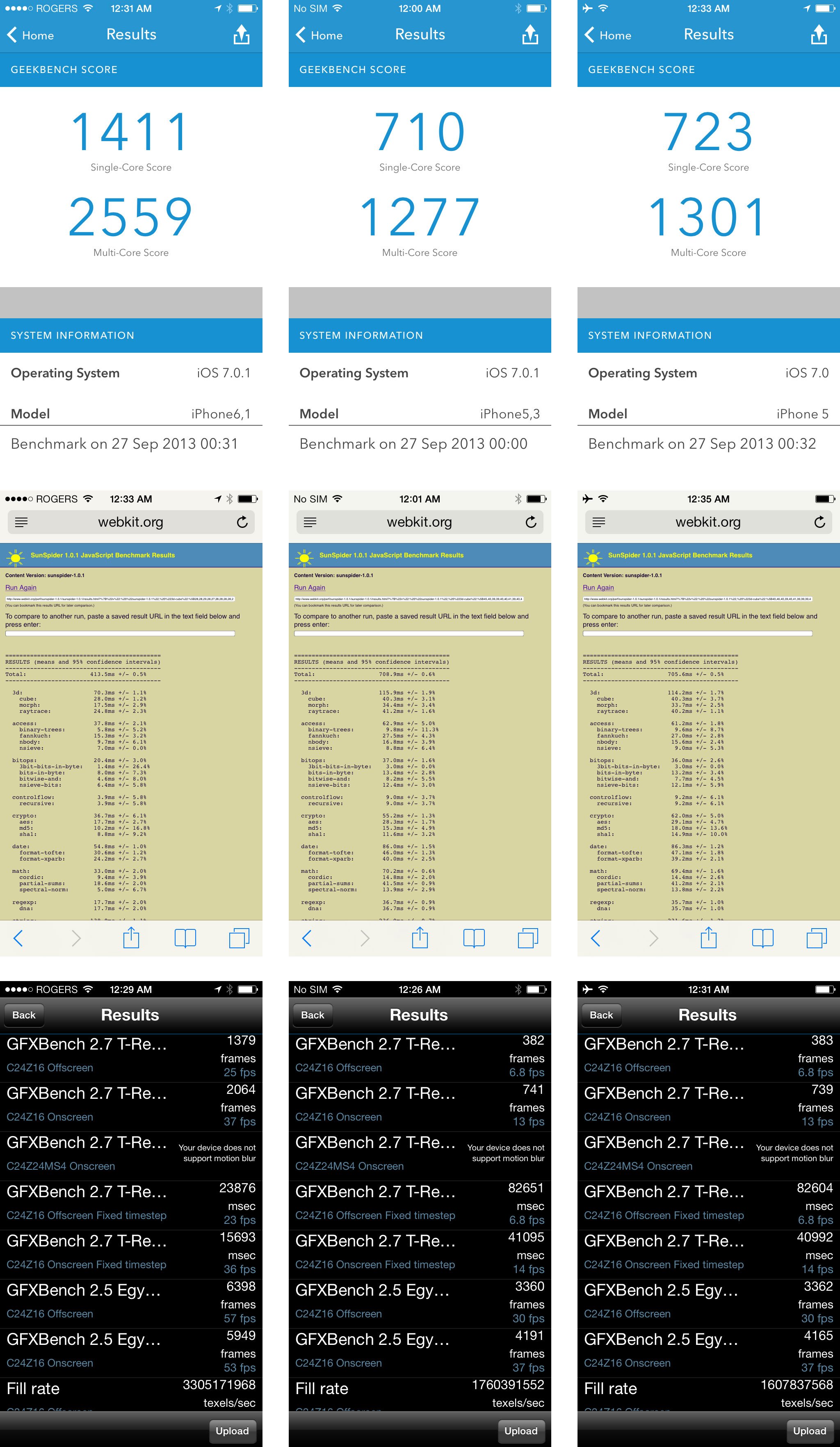
Like capacitive touch screens in a world that's resistive, and Retina displays when all eyes are on standard, 64-bit looks great on a slide, on a website, on a smart sign, and on a box. It sounds advanced. It sounds better than. It sounds leading if not bleeding edge. In a time when superficial public opinion is leaning away from Apple-as-innovator, innovative-sounding messaging could not be any more important.
It can also be confusing, however. Mass media has mostly been told - and passed along - the most obvious consumer-facing benefits of the bit-space, like the ability to address more than 4GB of RAM, and to work on much larger image and video files. It's easy to imagine a future where more powerful iPads and Apple TVs - both of which share the same processor architecture and operating system as the iPhone - can benefit from those capabilities, not to mention the Mac on ARM project at Apple that we might see the fruits of one day. It's harder to see an iPhone with 6 or 8GB of RAM any time soon.
Luckily the Apple A7 comes with several other advantages as well. First, the 64-bit ARMv8 instruction set is just flat out more efficient than the old 32-bit ARMv7 one was, and that efficiency helps. Second, the A7 is providing twice the general-purpose and twice the floating point registers as the A6 processor. Which was plenty fast already. The ability to chew through registers in particular is also a net positive. Registers are the memory units inside CPUs. They're what hold the bits being operated on at the moment. The more bits that can be held at once, the more operations that can be performed at once. And just like keeping bits in RAM is faster than moving them back and forth from physical storage, keeping them in registers is faster than going out to RAM or storage to get them.
Apple has already transitioned iOS 7. That includes native, 64-bit kernel, libraries, and drivers, built-in apps. They also made it as easy as possible for developers to compile for both 32- and 64-bit in Xcode, and will load both 32- and 64-bit frameworks on-device so the transition will be transparent and painless for customers as well.
Likewise, Apple claims the A7 GPU is also twice as fast as the A6. It's arguable whether or not Apple "gets games", and what they do with next-generation iPads, Apple TVs, and future devices remains to be seen. However, while "Console quality" is a term that gets thrown around a lot, 64-bit and OpenGL ES 3.0, shows Apple putting their tech where their mouth is.
It's hard to really appreciate speed until you go back to something that isn't as fast. Be it broadband vs. dialup, LTE vs. 3G, SSD vs. HDD, or a processor that's twice as fast vs. one that now feels twice as slow. But the difference, one you might never have noticed before, becomes instantly apparent. iOS 7 will be pushing the limits of modern smartphone hardware. Increasing those limits will not only make iOS 7 perceptibly better, but it will make the kind of apps iOS 7 can run perceptibly better as well.
All this power does come at a price, of course, and that price is also power. To help mitigate against higher battery demands, Apple has added a bigger battery to the iPhone 5s. 1570 mAh compared to 1440 mAh in last year's iPhone 5. I've only been using it for a week, and alternating between it and the iPhone 5c I've also been reviewing, but based on my use-case battery life has been roughly the same. I take it off the charger at about the same time in the morning, and plug it back in at about the same time at night. If I leave it off the charger at night, I wake up to find standby drain that's slightly higher than what I had on the iPhone 5, but only slightly.
We'll spend some more time testing it, and we'll update with our findings going forward, but I wouldn't expect anything less than any other iPhone has provided in the last few years, and indeed Apple's battery life estimates remain among the most conservative and reliable in the industry for that very reason. That said, aberrations occur, so:
Apple M7 motion coprocessor
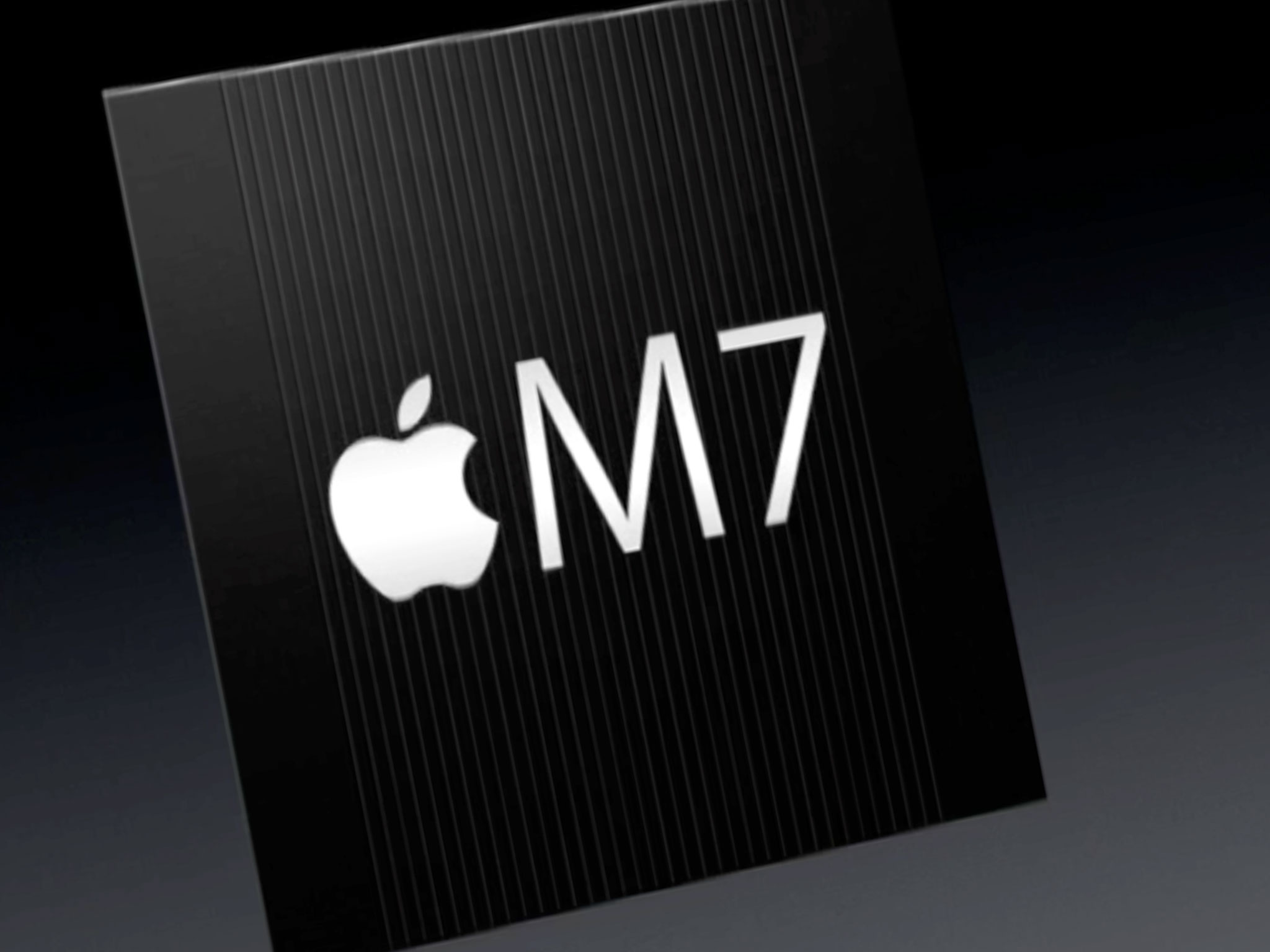
The Apple M7 motion coprocessor is Robin to the A7's Batman. Watson to its Sherlock. Chewbacca to its Han Solo. You get the idea. It's something that helps take some of the busy work off the hero's back. It's the sidekick. Codenamed Oscar, Chipworks believes the M7 is Apple's branding for an NXP LPC1800 micro-controller based on an ARM Cortex M3 processor. On the iPhone 5s it does exactly what that branding implies - it collects and keeps all motion data, including the built-in accelerometer, magnometer (digital compass), and gyroscope.
That means, at any given point in time, the M7 coprocessor knows how your iPhone 5s is moving (or not moving), which direction it's facing, and what its orientation is in 3D space. By extension, the system and apps can extrapolate some motion data about you as well. For example, with the M7, when you park and get out of your car, the location of your vehicle could be noted and maps could be switched from driving to walking directions. When you put your iPhone down on the bedside table for the night, network checks could be slowed down so even more power is conserved.
Previously, the main A-series processor would have had to stay awake, or wake up, to do all this, destroying battery life, or it would simply record activity only when it was awake, leaving huge gaps in the motion timeline.
To access all of this data, Apple is providing an updated CoreMotion API to developers. It contextually identifies different activity states, such as stationary, walking, running, and driving, and provides access to a week of historical data immediately. So, instead of a plethora of motion-oriented apps all wanting to stay active in the background to record their own data, each one will simply wake when you want it to, pull the data from the M7 coprocessor, and present it to you just-in-time. And when you get a new app, you don't start from scratch. You get everything already stored on the M7.
That's a far, far more efficient way of handling health, fitness, utility, and novelty apps on both the hardware and software level. Developers can also, if needed, tie into aGPS/GLONASS to add location data to the mix. It's not as power friendly as pure M7 motion data, but it can help create full-blown athletic fitness apps.

Google's Moto X, by contrast, has two coprocessors, a natural language core and a contextual awareness core. That lets it, for example, listen for you to say "Okay Google Now". I'd love it if Apple added a dedicated Siri coprocessor to handle on-device voice parsing and predictive analytics, but Apple decided to focus on the sensor fusion hub this time.
So, could M7 also be used to prevent certain activities, for example, to lock out things like messaging when it detects you're in a car? Possibly but problematically. How would it know if you were driving or merely a passenger? Behind the wheel or at the back of the bus or train? And if it allowed for a manual override to handle those exceptions, what's to stop a negligent driver from using it to continue on their negligent way?
Distracted driving of all kinds is a lethal problem. M7-based lockout, by itself and as presently implemented, however, doesn't seem like a realistic solution. We'll have to see if things like iOS in the Car offer any better alternatives.
Just like GPS/GLONASS apps have to ask your permission to use your location data, M7 apps have to ask your permission to use your motion data. if you change your mind later, you can either re-enable or disable access in Settings > Privacy > Motion Activity.
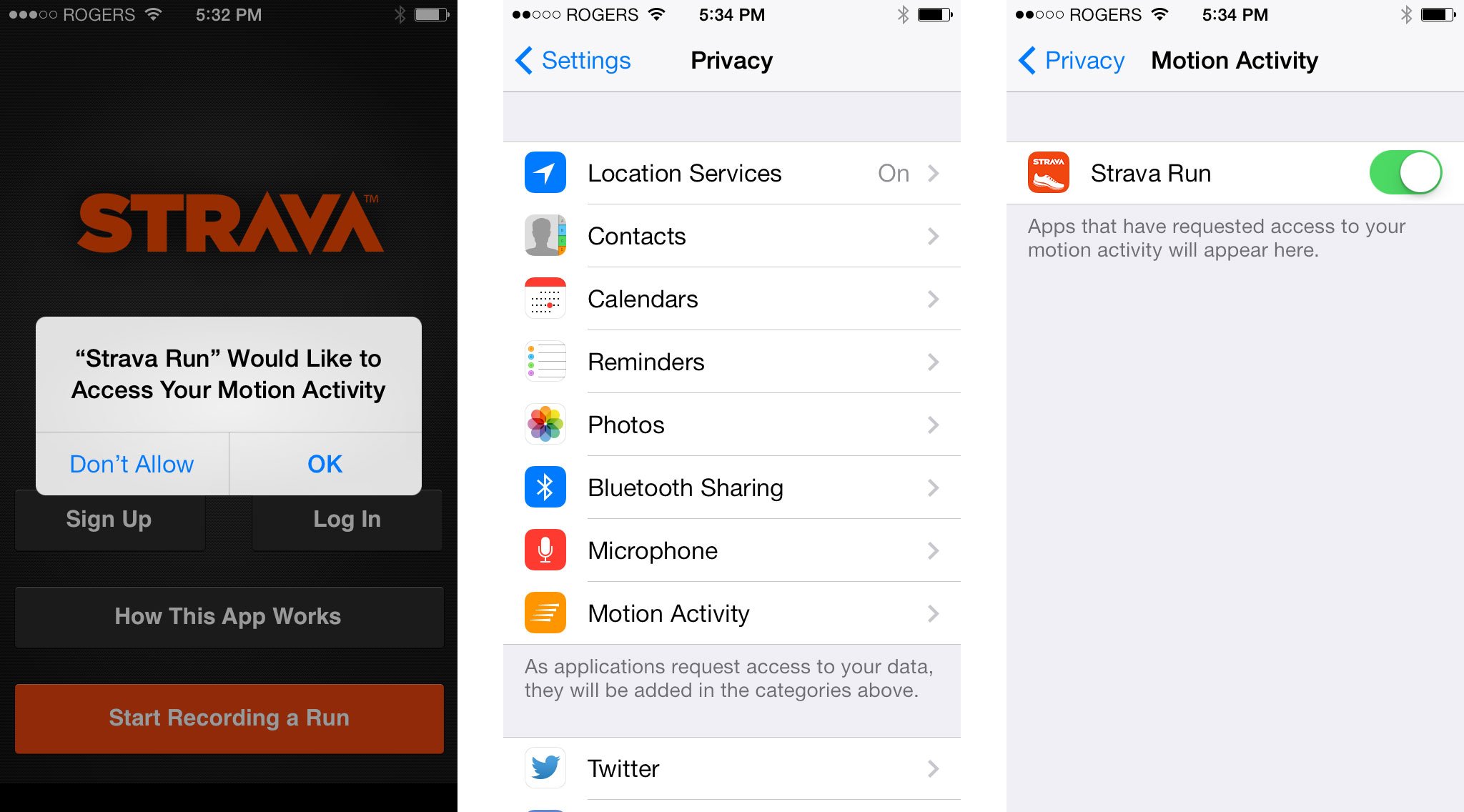
M7 is only storing that your iPhone is moving and how vigorously, in which direction, and its orientation, and reportedly only for 7 days. If an app or agency were to gain access to that information, they might be able to tell your iPhone had been left still for a long period of time, or had been jostled about at certain time, or moved along a specific path for whatever duration. It's no more or less information than anyone could have gotten before the M7, its just continuous rather than periodic. If that's a concern, don't grant access.
I've bought and used the Nike Fuelband and Jawbone Up and Fitbit and they've always been just one more thing to charge, to carry, and to try not to lose. I already have my iPhone with almost everywhere I go, so why not let it serve as the central hub for quantified-life-style health and fitness services. Instead of a Nike or Jawbone or Fitbit band, I can simply have an app. It also sets the stage for a wider array of motion-related apps in the future. That's beyond exciting.
iPhone 5s Touch ID fingerprint identification sensor
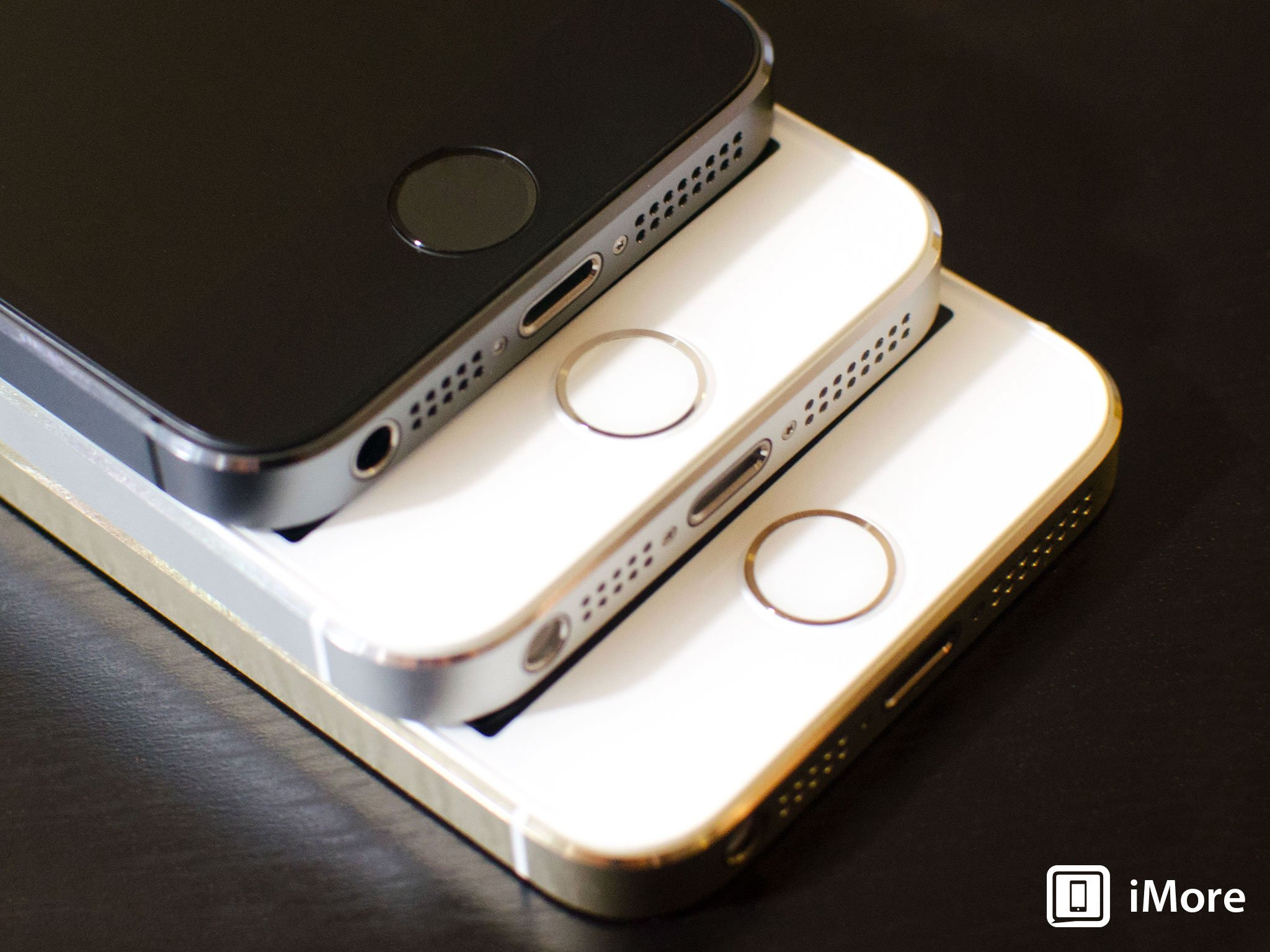
The Home button is incredibly important on a mainstream computing device like the iPhone. Not only is it an easy, physically reassuring way to wake the system, it's an escape hatch that can anybody can use at any time to return to a known state - the Home screen - no matter how frustrated, lost, or confused they feel. It's a safety net. A security blanket. Which is why it makes perfect sense for Apple to use the Home button to introduce their new biometric fingerprint identity sensor, Touch ID.
According to Apple, roughly half of their hundreds of millions of iPhone customers don't use a passcode - a simple 4 digit combination lock - much less a password - a long, strong alphanumeric, potentially pseudo-random string, to secure their devices. That's a problem. It leaves the device open to everything from pranks to snooping, and makes them a better target for thieves,
Yet it's understandable. Entering passwords on mobile has improved over the years, yet mobile keyboards, especially virtual ones, still absolutely suck when it comes to reliably, consistently, precisely entering long, pseudo-random strings. It sucks so much that many people continue to leave passcodes turned off, and keep their iTunes passwords simple and easy to enter. And that's not good for anybody.
With Touch ID, however, you can authenticate and unlock your iPhone, and authorize purchases on the iTunes Store, App Store, and iBookstore with, literally, the touch of your finger. It's less secure than a strong password, but much more likely to be used than even a weak passcode. In the perpetual battle between security and convenience, where many people opt for the ultimate convenience of no security at all, Touch ID aims to do for authentication and authorization what iCloud did for backup and restore - make it easy enough that most people, regardless of whether or not they're tech savvy, will actually use it.
The Touch ID implementation itself looks clever. A highly scratch-resistant sapphire glass lens protects the assembly and focuses the sensor, while a color-matched steel ring surrounds it, waiting to detect your finger. When that's triggered, the capacitive Touch ID sensor activates and takes what's effectively a high-resolution snapshot of your fingerprint. The sensor is orientation independent, and can read a fingerprint in 360 degrees, which makes it fairly robust. A mathematical representations of the snapshot is compared against the mathematical representation of the fingerprint that's stored in the secure enclave on the Apple A7 chipset, and depending on whether or not the characteristics in the arches, loops, or whorls match, a "yes" or "no" token is returned to the system.
If the token is "yes", you're instantly authenticated and your iPhone 5s will unlock or your iTunes purchase will be authorized. Touch ID will also add incremental data from the authenticated snapshot to improve the quality of the existing fingerprint record.
If the token is "no", iOS will shake its interface head at you and make you try again, force a passcode entry, or if you're not you, keep whomever it is locked out of your stuff and your account. (I love, love, love that the interface head-shake from OS X is used in iOS for this. Such a great, charming, communicative metaphor.)
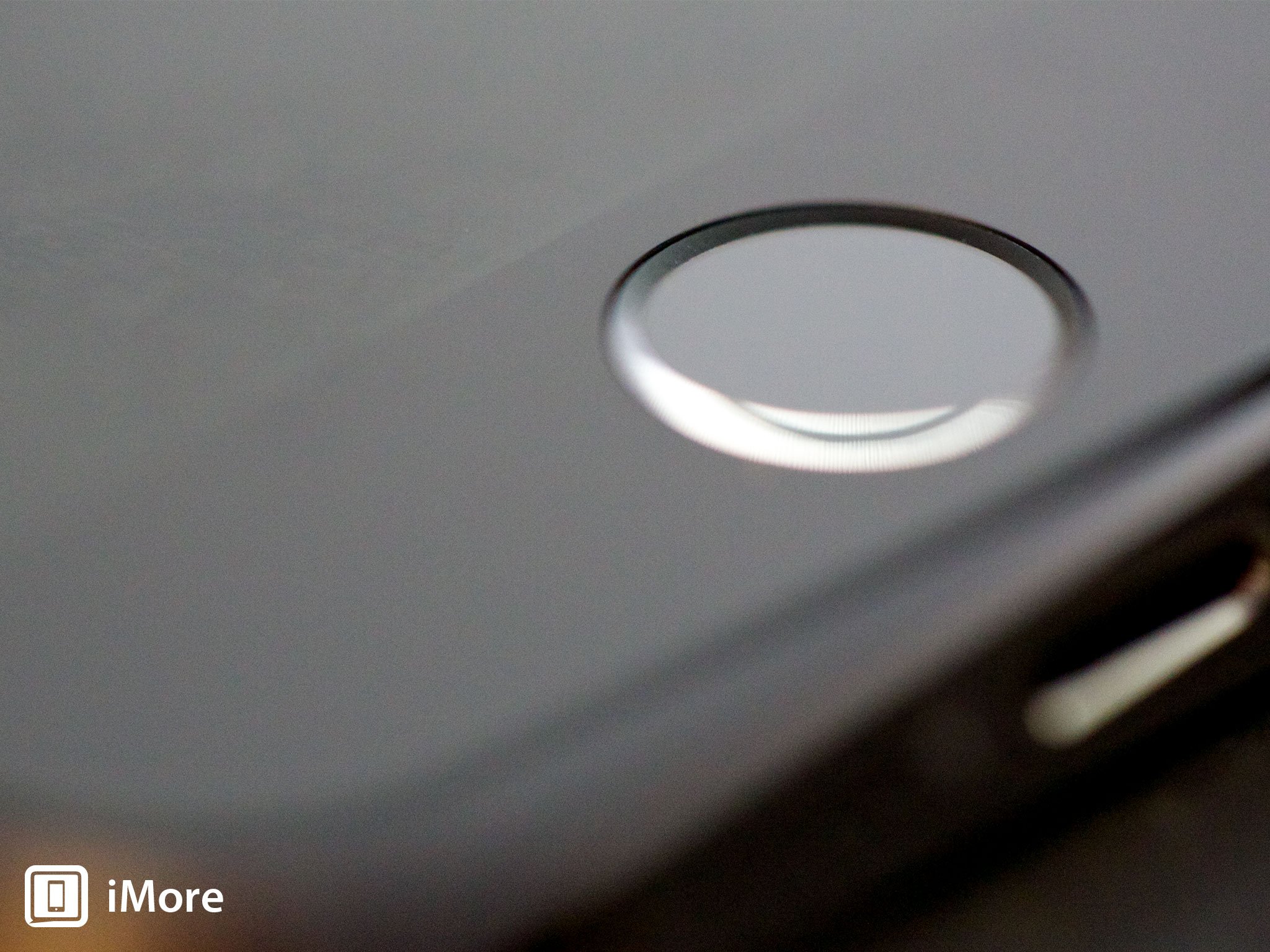
The Touch ID sensor is wafer thin, measuring only 170 microns. However, it can take 550ppi scans, which allows for a good level of detail analysis. It's also capacitive and reads the fingerprint at a sub-dermal level. That means it's not reading the dead skin on the top of your finger, but the new, living skin beneath the surface. That really doesn't mean anything beyond it having the ability to take good scans, however. Half of YouTube is currently filled with people scanning - and using - everything from their nipples to other parts of their anatomy, to animal paws to CSI-style molds to you name it, with Touch ID. If it's capacitive and has an identifiable pattern, chances are it will work. However, it will still be locked to that nipple or paw or mold.
You train Touch ID by holding a finger repeatedly against the Home button, and every time you use it it gets better at recognizing that finger. I had a little trouble with it at first. Your iPhone will buzz when it wants you to tap, and I couldn't get the timing or rhythm right. I wasn't expecting it, so I got skittish and removed to early, then didn't stay long enough, then too long. Then I failed to properly scan one edge when Touch ID prompted me to do the extended coverage pass. Clearly, first times are awkward and never easy. Subsequent training sessions have all gone off without a hitch.
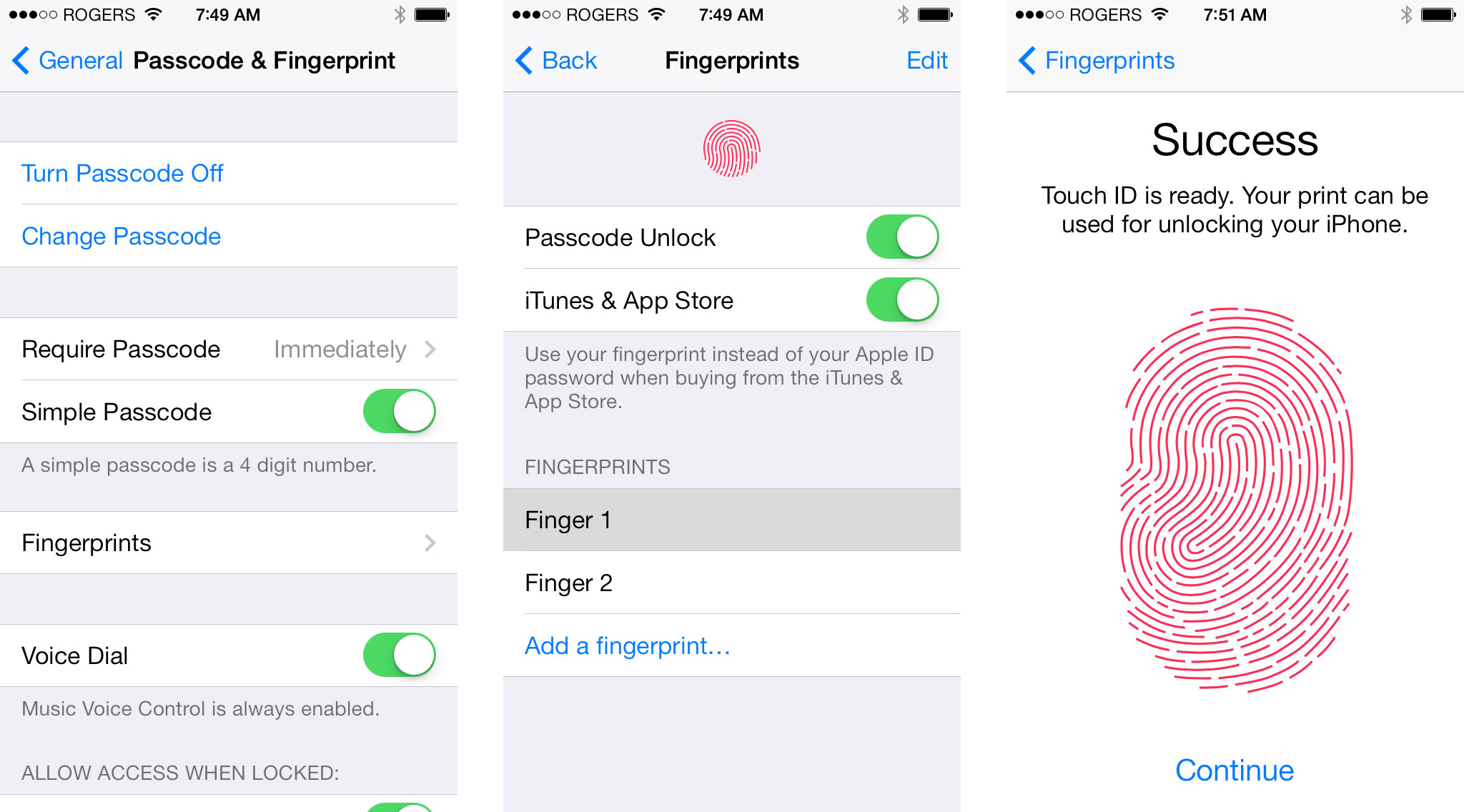
You can also train Touch ID to recognize up to 5 fingers. Either up to 5 of yours, on either hand, or up to 5 of yours, your family members, friends, colleagues, etc. (You can also train more than one finger in each of the 5 slots, if you really want to go to the time and effort, but that's dodgy at the moment and might disappear in a future update.) Multiple fingers, however, are important for environments where an administrator is managing a large number of devices for Enterprise, or in a household where several people might need access to the same device.
Once that's done, you can select in Settings whether you want to enable Touch ID for Passcode unlock, for iTunes and App Store (and iBookstore) purchases, or both. The system won't let you set up Touch ID unless a passcode is set, and set to be required immediately for unlock. (No sense having a biometric door if it's left unlocked.) It'll also make you authenticate via passcode before it'll allow any purchases inside the store. It might seem like a hassle, but it's nothing compared to how often iTunes asked for passwords before Touch ID.
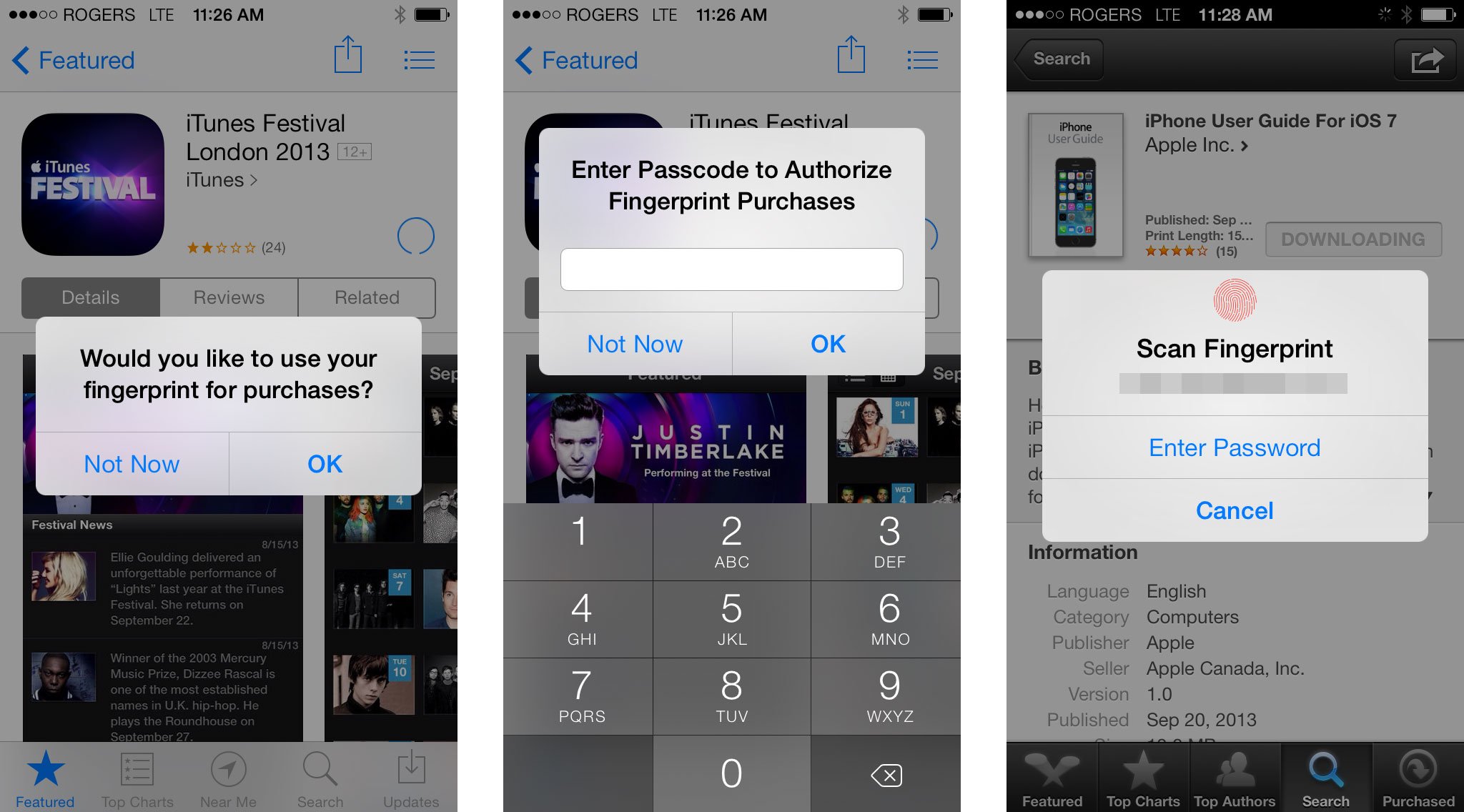
If you reboot your phone, you'll have to enter your passcode to unlock, and to re-enable Touch ID, or your Apple ID to re-enable iTunes purchases. If an unregistered finger is used, Touch ID will return a "no" token. After 5 unsuccessful attempts, you'll have to enter your passcode to unlock and re-enable Touch ID, or your Apple ID to re-enable iTunes purchases. If more than 48 hours have passed since you last used Touch ID, you'll have to enter your passcode to unlock, and re-enable it.
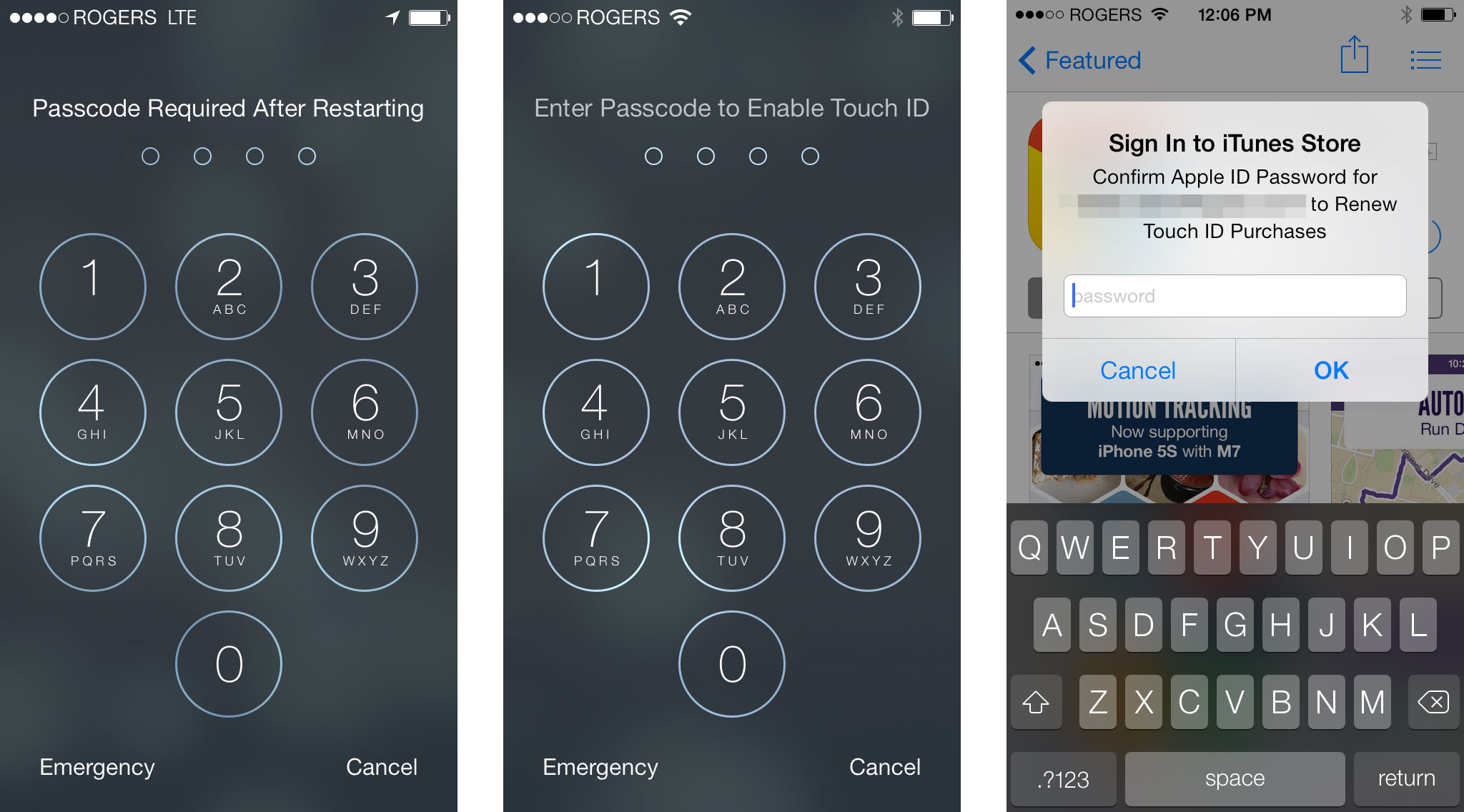
You can use a strong password instead of a 4-digit passcode for added security. However, you can't require the system ask for your passcode or password and Touch ID. In other words, Touch ID can be used to substitute factors (something you are vs. something you know), but it can't be used as part of a multi-factor authentication system (something you are + something you know). Multi-factor authentication is desirable - sometimes mandatory - in government and enterprise.
Because the Apple A7 chipset has built-in support for authentication, the process is lightning fast. Because it's happening in hardware rather than entering the software or online services space, a mathematical representation is being stored rather than the actual fingerprint image data, and only a token is being released, the system looks to be reasonably secure. However, every system is secure until it isn't, so only time can really tell.
Any physical security system can be attacked physically. According to Apple, there's a 1 in 50,000 chance for a random fingerprint match. You can also be overpowered - or legally compelled to - have your finger forced onto the Touch ID sensor. You can be asleep or rendered concussively or chemically unconscious and have your finger placed onto the sensor. You can have fingerprints lifted from the objects you use, scanned and printed at high resolution, and used to spoof the sensor.
Likewise, any informational security system can be attacked informationally. There's a 1 in 10,000 chance for a passcode to randomly match. You can also have your passcode spied on, seduced, intimidated, or otherwise tricked out of you. The single best way to get someone's password is still to ask them for it. No security system is absolutely secure, or you couldn't get into it either. It's all about degrees.
There's also the matter of privacy and identity. Privacy is the single biggest issue of our time, and identity is the next big digital land-grab. Everyone wants to not only know who we are, but be able to prove it. Facebook and Google do it by demanding we broadcast our real names to the world lest we risk being locked out of our own accounts. Apple is doing it with fingerprints, which are intimately more personal, though far less public. And while that may have some advantages, it also has consequences. Using your fingerprint to authenticate and authorize a transaction means it's your fingerprint on that transaction. Sure, fingerprints can be spoofed like passcodes or passwords can be circumvented, but: "I must have left my phone on the table, someone else did [insert potentially embarrassing or illegal thing here]!"
Of course, no one has to use Touch ID. You can opt to still use an old-school passcode or password, or - but please don't - nothing. Some people might not care about that at all, of course. Convenience trumping privacy, and security trumping freedom be damned. Those who are already taping over webcams and microphones will likely want to put an opaque sticker over Touch ID as well.
For most of us, however, Touch ID has a better security-to-convenience ratio than either a 4-digit numeric password or 63-character pseudo-random password. Personally, I read everything I could find, tried to understand it as best as possible, and came to the most informed decision I could. I'm using Touch ID. A lot. And I hope to see it on the iPad line soon, and hopefully one day, the Mac.
Because it really does just work. Occasionally, it misses the first read due to angle or moisture, but 95+% of the time it works so well you forget it exists. That can be momentarily frustrating, for example, if you idly leave your finger on the Home button and unlock before reading your Lock screen notifications, but you can just pull down Notification Center proper. It can also be incredibly frustrating when you reach for an iPad, wait, and then realize you have to enter a passcode. Like an animal.
That's the problem with the future when it works this well. You can't go back.
iPhone 5s iSight camera
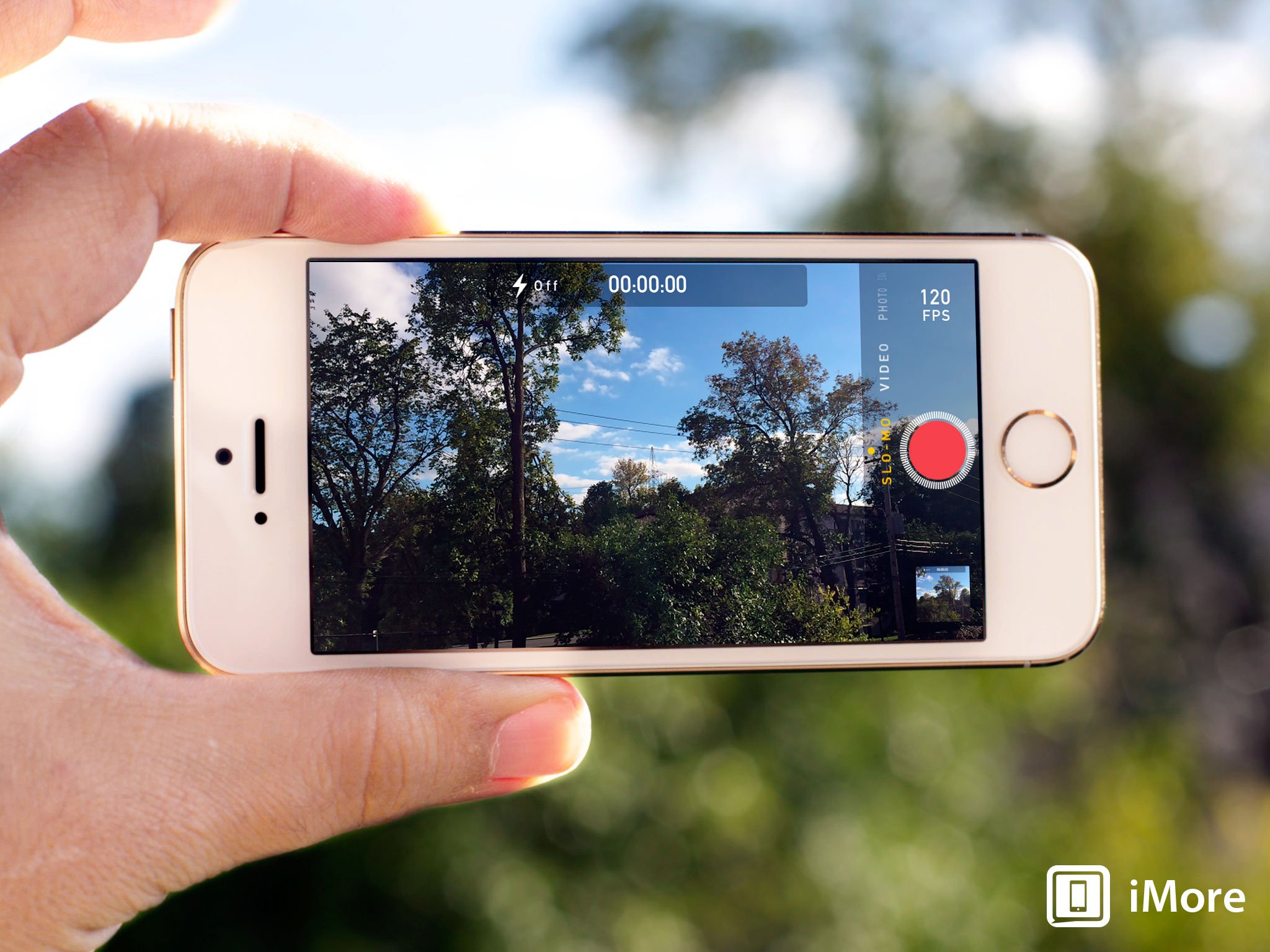
Apple's goal when it comes to mobile photography is apparent. They're not interested in the biggest glass or widest range of features. They want to help you take the best photographs you can, any time, and under any conditions you need to take them. If something magical happens, they don't ever want you to miss out on capturing it. They don't want you to have to fret with settings or search for features and miss out entirely, or, if you manage to capture it, be disappointed that it turned out too dark or too blurry, or too soon or too late.
That means they leave a considerable amount of bullet points off the list, but so far it's been difficult if not impossible to argue with the choices they've made. The iPhone 5s iSight camera continues down that path. It makes very specific compromises, given the size, and more specifically the depth, of the device, and yet increases the scope of Apple's "everyday photos" mantra considerably.
Better balance, better exposure, better sharpness, better low-light, less color distortion, less motion blur, and less chance you miss your shot by mere moments.
For general photography, the iPhone 5s camera performs excellently, as expected. It's the same 8 megapixel count as last year's iPhone 5, but the new image signal processor (ISP) in the Apple A7 chipset manages to balance tone and saturation better, and produce truer color. The shutter speed is also impressive. Where before you'd take the picture then wait to see how high you could count before the animation finished and your photo was saved, now you take a picture, the screen flashes, and it's saved. It's so fast I sometimes don't even realize it's happened and I end up taking the shot again. Much of that is thanks to iOS 7's new interface, but part of it is the A7 chipset. For example, it makes focus faster. Apple claims 2x. It's hard to measure, but it's appreciable. That whole chain from "I want to take a photo" to the photo being taken, that race-to-shoot, feels better every step along the way.
From left to right, iPhone 5s, iPhone 5c, iPhone 5:
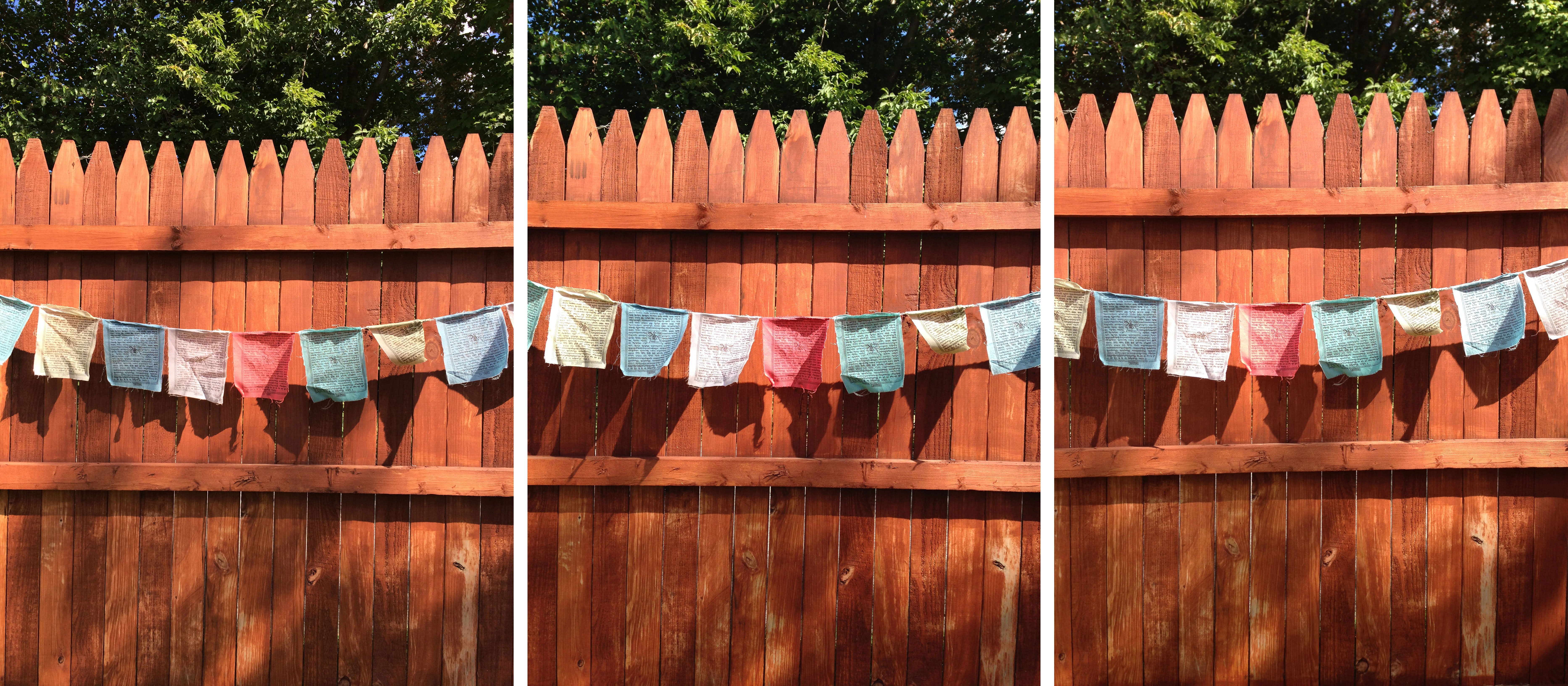
In addition to the auto white balance, auto exposure, and face detection features previously introduced, the A7 ISP now creates a dynamic local tone map to better balance highlights and shadows. It's not quite the same as high dynamic range (HDR) - there's still a dedicated mode just for that - but it does provide for images that are less likely to be swampy or blown out. The iPhone 5s camera also does autofocus matrix metering, which means it measures 15 focus zones to make sure it gets the best exposure possible.
From left to right, iPhone 5s, iPhone 5c, iPhone 5:

Instead of more megapixels, Apple once again focused on better pixels. They increased the size from 1.4 to 1.5 microns, and aperture from f/2.4 to f/2/2. that won't make a huge difference in almost no light (there's a flash for that, see below). But in dimly lit rooms, twilight, and other, common situations, the difference is notable.
Apple has also added electronic image stabilization (EIS) as well. It's not the same as the optical image stabilization (OIS) system some competing phones have been using for a while now. OIS is a hardware solution that stabilizes the lens itself. It does a good job minimizing noise and the effects of your hands shaking, but is still subject to blur when something moves in the scene.
EIS, on the other hand, is a software solution that takes four photos with shorter exposures, selects the sharpest areas of each one, and then combines them into a single, final photo. In theory, this should accomplish pretty much the same thing as OIS, and could conceivably do a better job with slight motion in the scene. However, I tend to like the idea of better capture up front. In a perfect world, we'd have both.
From left to right, iPhone 5s, iPhone 5c, iPhone 5:

The iPhone 5s' new, dual LED True Tone flash isn't any brighter than the previous single LED. To go brighter, Apple would need to go to technology like Xenon. However, since mobile flash photography stinks no matter the quality of the tiny elements, Apple's trying to go as good a job as they can to help you best capture moments that couldn't be captured without a flash.
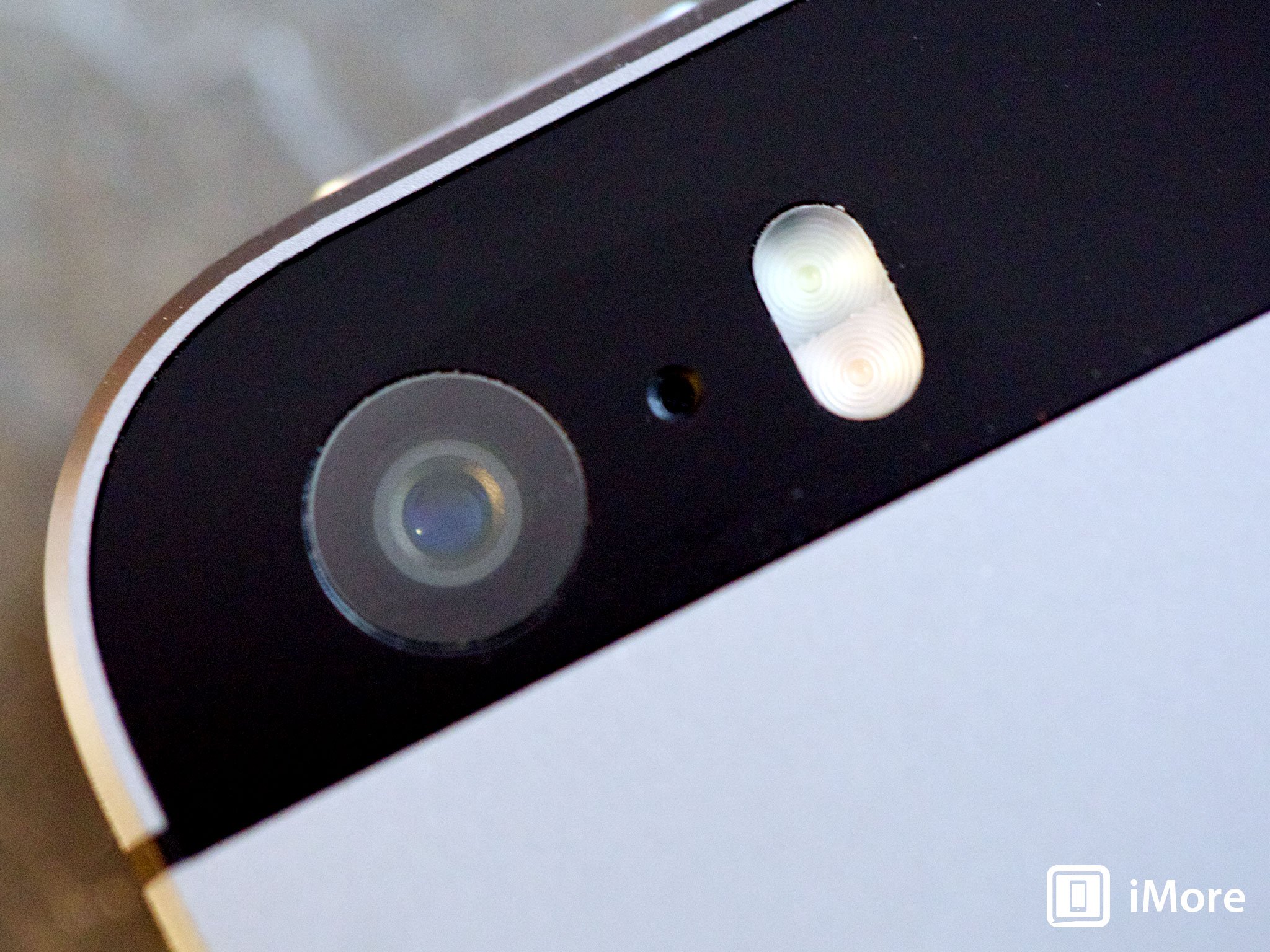
The challenge is, even in extreme low light, what light there is can be one of several different types, from twilight to incandescent, tungsten to florescent, and combinations in between. Some are colder, with more of a blue or white cast to them. Some are warmer with more of a yellow or orange cast. A Standard LED flash can't match that range, so Apple has included two. True Tone has a white element for the cooler/blue end of the spectrum, and a yellow element, for the warmer/yellow end. When fired, they can intelligently adjust intensity and color temperature to any one of over a a thousand combinations in order to best match the scene being shot. That allows for better, more natural looking flash photos.
From left to right, iPhone 5s, iPhone 5c, iPhone 5:
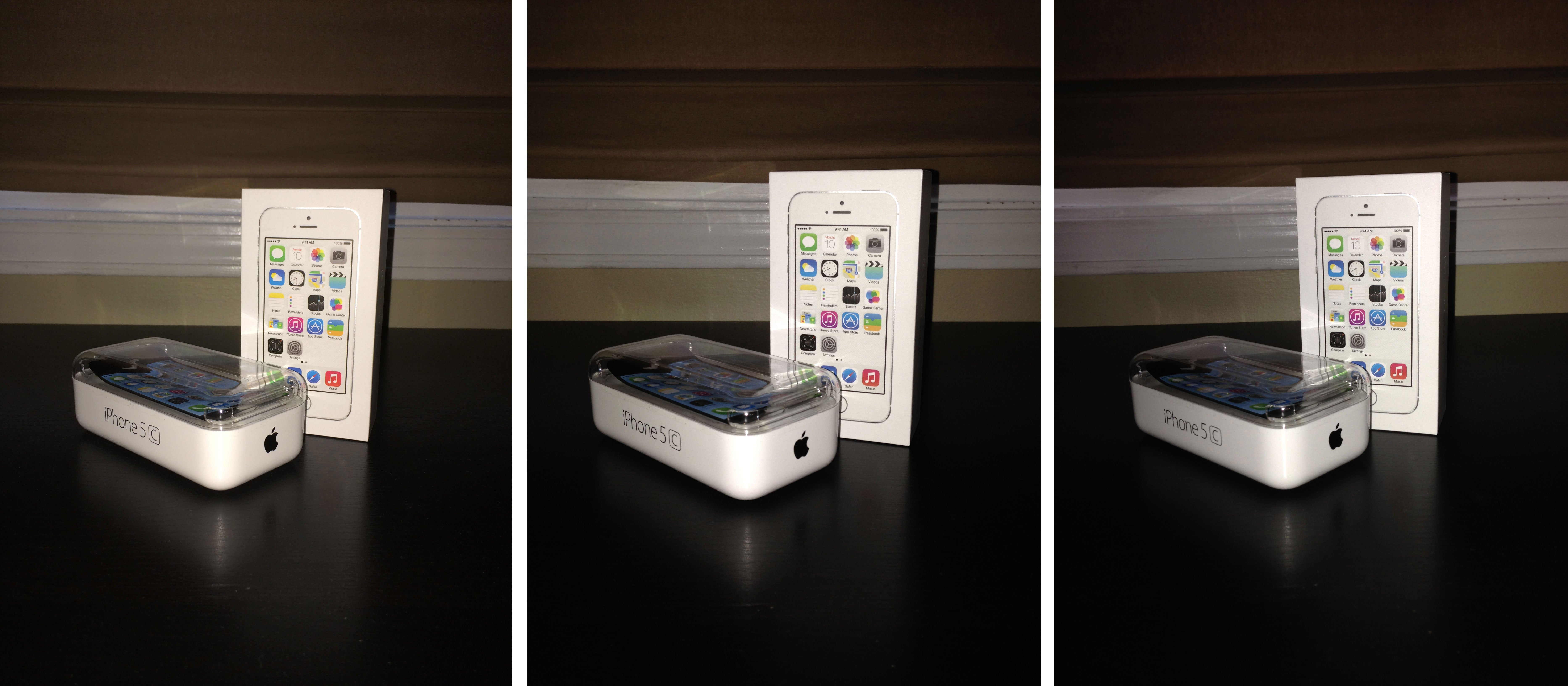
.
For panoramas, the A7 allows for faster, 30fps captures, and more importantly, for dynamic exposure that adjusts to changes in lighting continuously from beginning to end. The results are excellent.
From top to bottom, iPhone 5s, iPhone 5c, iPhone 5:



Apple's version of improving action photography is called Burst Mode, and it's so very typically Apple. With iOS 7 you can hold your finger down on the shutter button and take bursts of photos. On the iPhone 5s with the A7, it will not only burst at 10 frames per second, but the ISP will automatically, in real time, analyze all those photos and select the best shots. From there, the iOS 7 Camera Roll will present you with those selections, including major action moments if any, but also let you drill down into the entire series if you really want to.

So, whether you're trying to get that perfect shot of snowboard acrobatics, or simply that one crisp moment amid the chaos of children, the odds are suddenly in your favor. You get the advantage of multiple shots, without any of the unmanageable overhead.
Though not exclusive to the iPhone 5s, iOS 7 also adds a new square camera mode, and new, subtle live filters: Mono, Tonal, Noir, Fade, Chrome, Process, Transfer, and Instant.
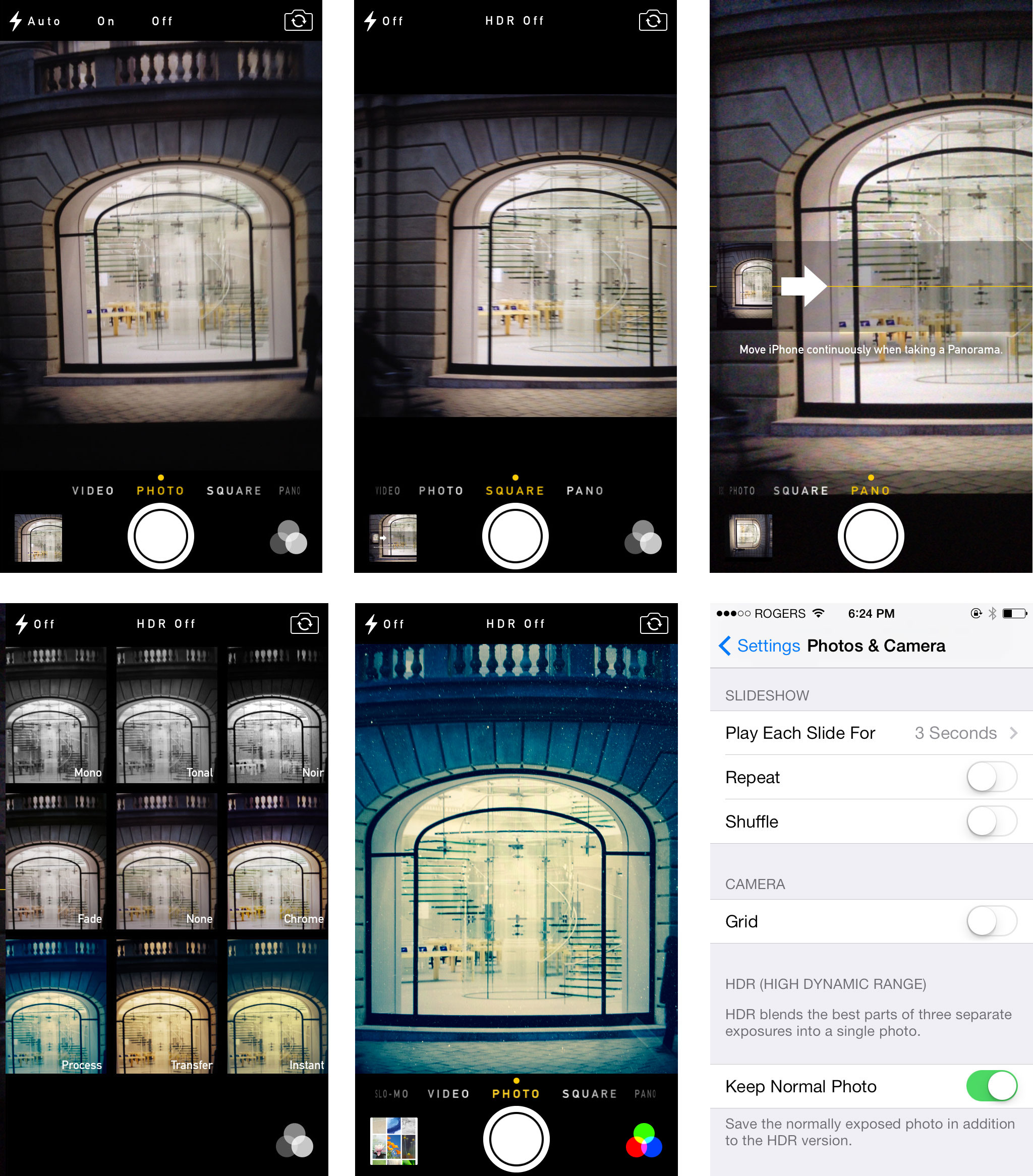
Video recording remains the same 1080p 30fps as previous years, which is fine. Mobile 4K/2160p is starting to appear but is by no means common yet. You can digitally zoom up to 3x while shooting video, but digital zoom is as terrible for movies as it is for still, so I'll stick with sneaker zoom whenever possible. The better addition here is slow motion mode. You access it by swiping to the left of Photo, and past Video, until you get to Slo Mo.
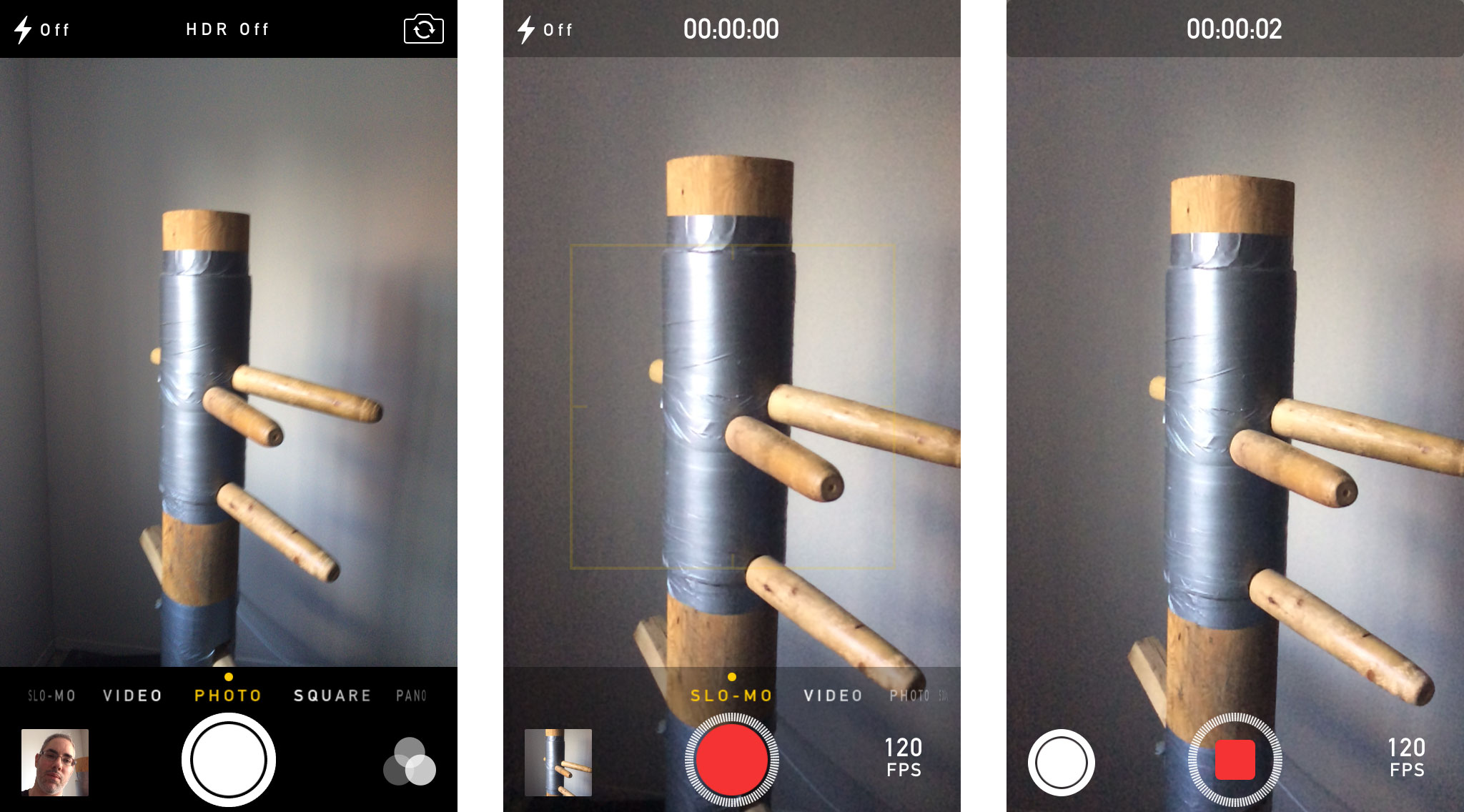
Then, instead of the usual 1080p 30fps, you get 720p 120fps. That's 4x speed, meaning crystal clear 4x slow motion. It would be nice if there was an option for 1080p 60fps as well, but I won't be overly greedy. Yet.
Once you're done, iOS 7 gives you an excellent, intuitive interface to not only clip, but to set slow motion in and out points. Once set, you can save and share it via the usual sheet.
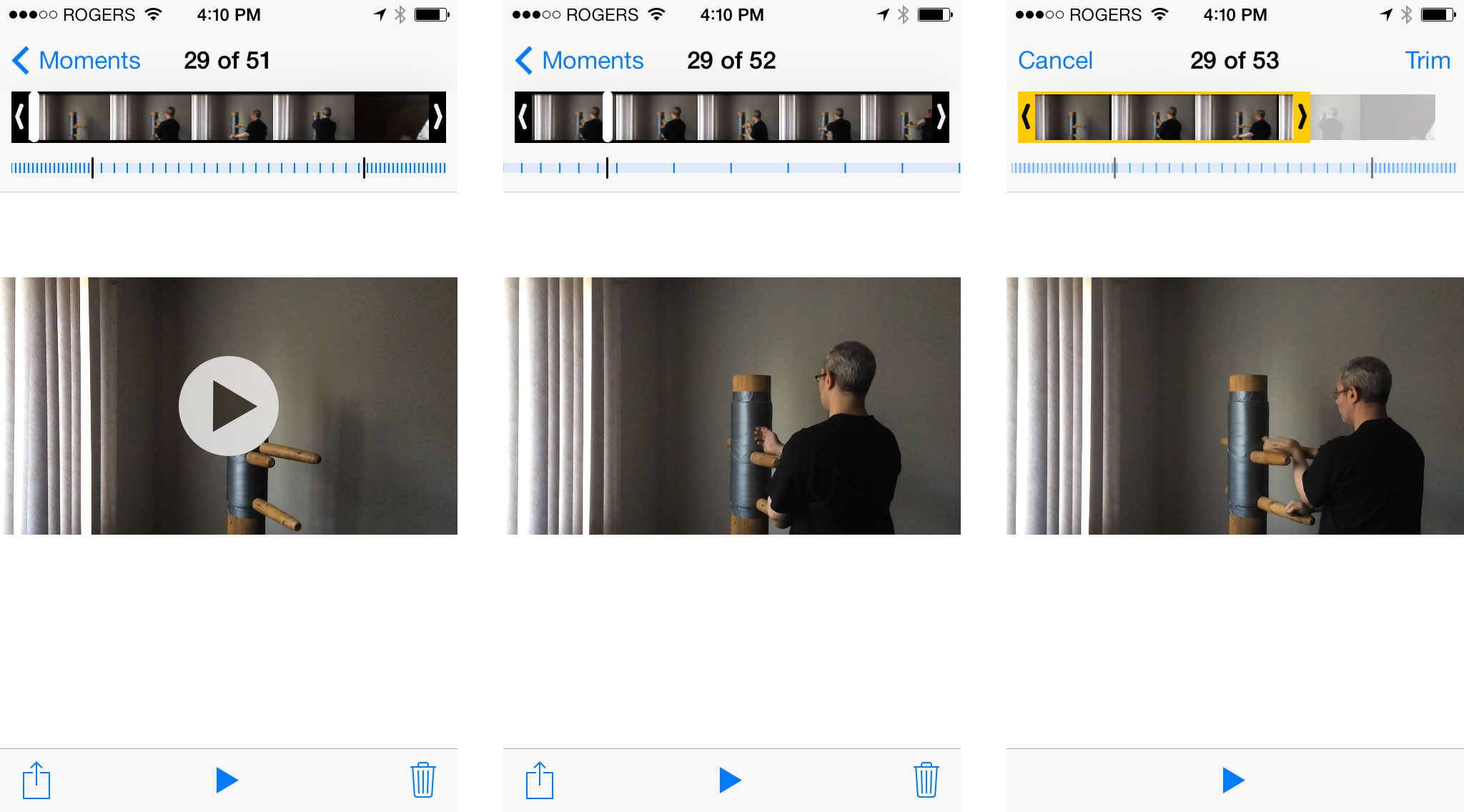
Importing it onto your computer is more of a challenge. If you just pull off the raw video it'll still be 120fps but you'll lose the metadata in and out points you set on iOS. OS X Mavericks will likely address this later this fall, perhaps by keeping and letting you use the iOS metadata. Until then, you can import the full 120fps video into apps like Final Cut Pro X and reset the in and out points using standard tools
Overall it's incredibly easy to use, and a lot of fun. I imagine we'll see a ton of jumping pets, colliding kids, and Reservoir Dogs reenactments, and perhaps some clever bullet time too. At least from me.
iPhone 5s FaceTime HD camera
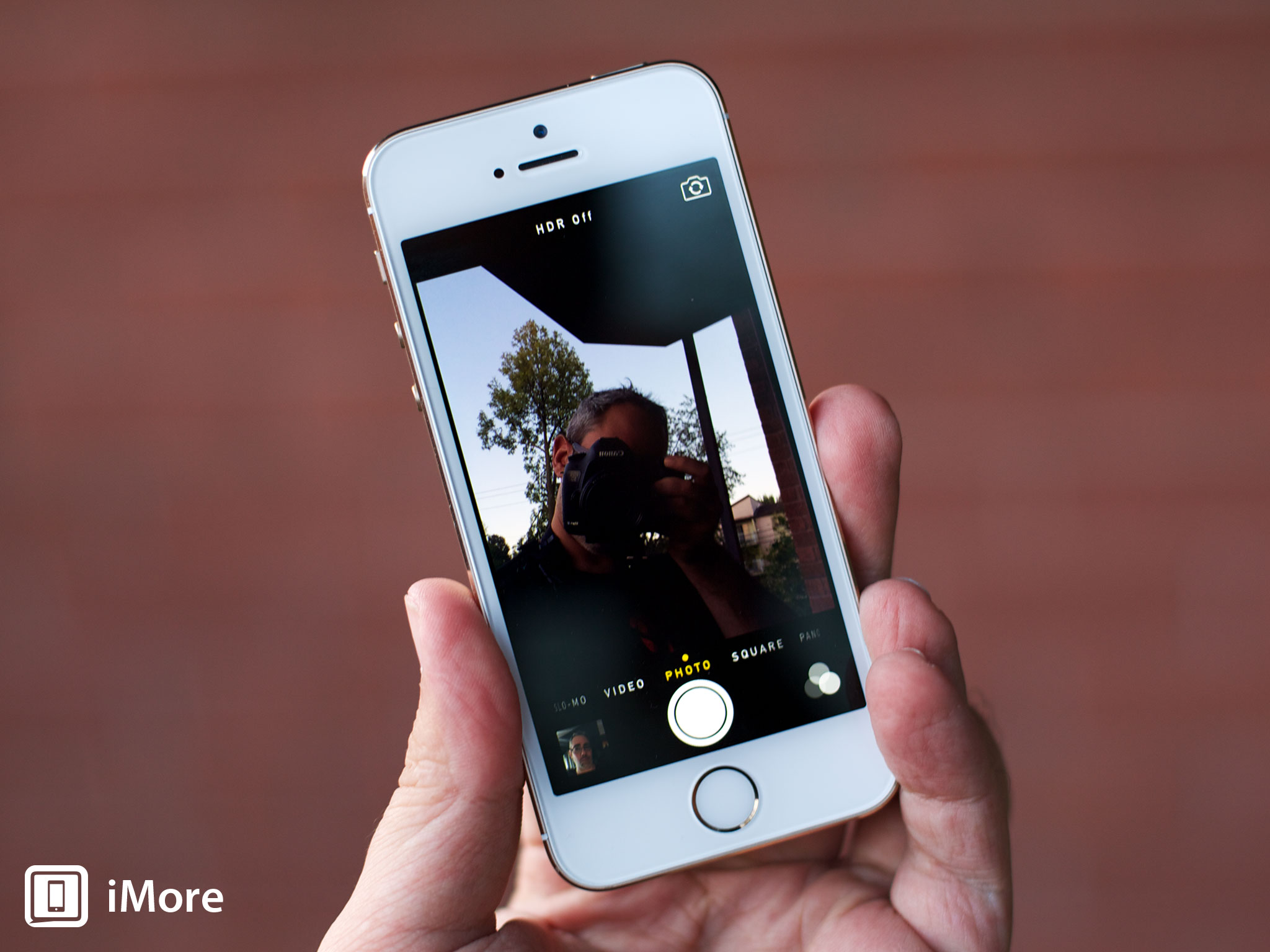
The iPhone 5s also has a bigger, better FaceTime HD camera on the front. The pixel size has increased to 1.9 microns from 1.75 on the iPhone 5, and Apple's changed to a back illuminated sensor (BSI), which allows it to capture more light.
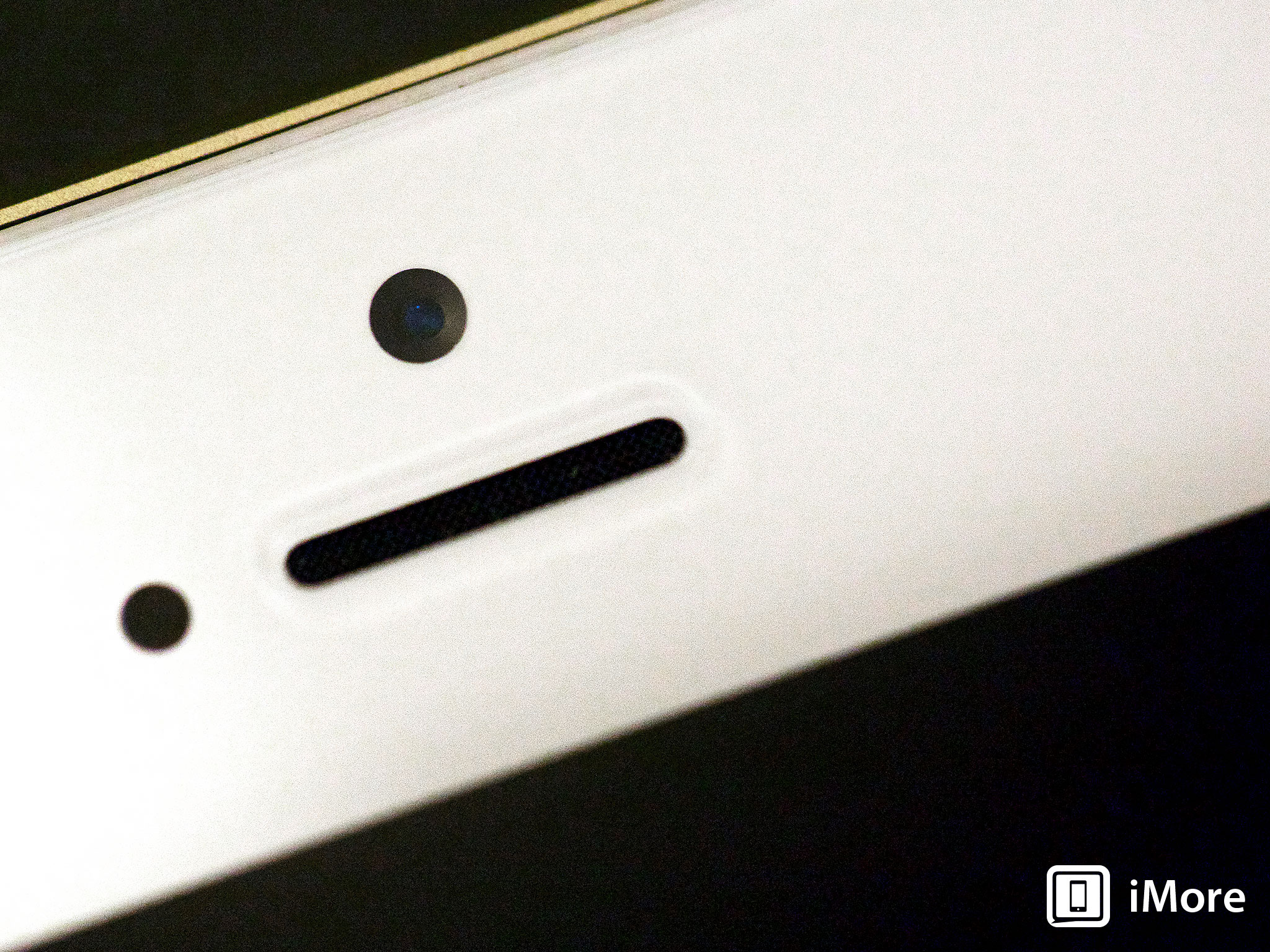
In daylight, once again, the differences aren't as obvious. However, the iPhone 5s, like the iPone 5c, shows a better range of tons. From left to right, top to bottom: iPhone 5s, iPhone 5c, iPhone 5, iPod touch 6.

In low-light the difference is more obvious. From left to right, top to bottom: iPhone 5s, iPhone 5c, iPhone 5, iPod touch 6.

When it comes to video, good lighting once again shows how well even the older FaceTime HD cameras show up. Low-light, however, shows where the iPhone 5s ISP really shines, correcting color to a level beyond what even the identically specced iPhone 5c can match.
Unless you take a ton of selfies, or make a ton of FaceTime video calls in low-light - hey, judgement free zone! - it's not a major difference. But, added together it's part of what makes an overall better package.
iPhone 5s LTE and radios
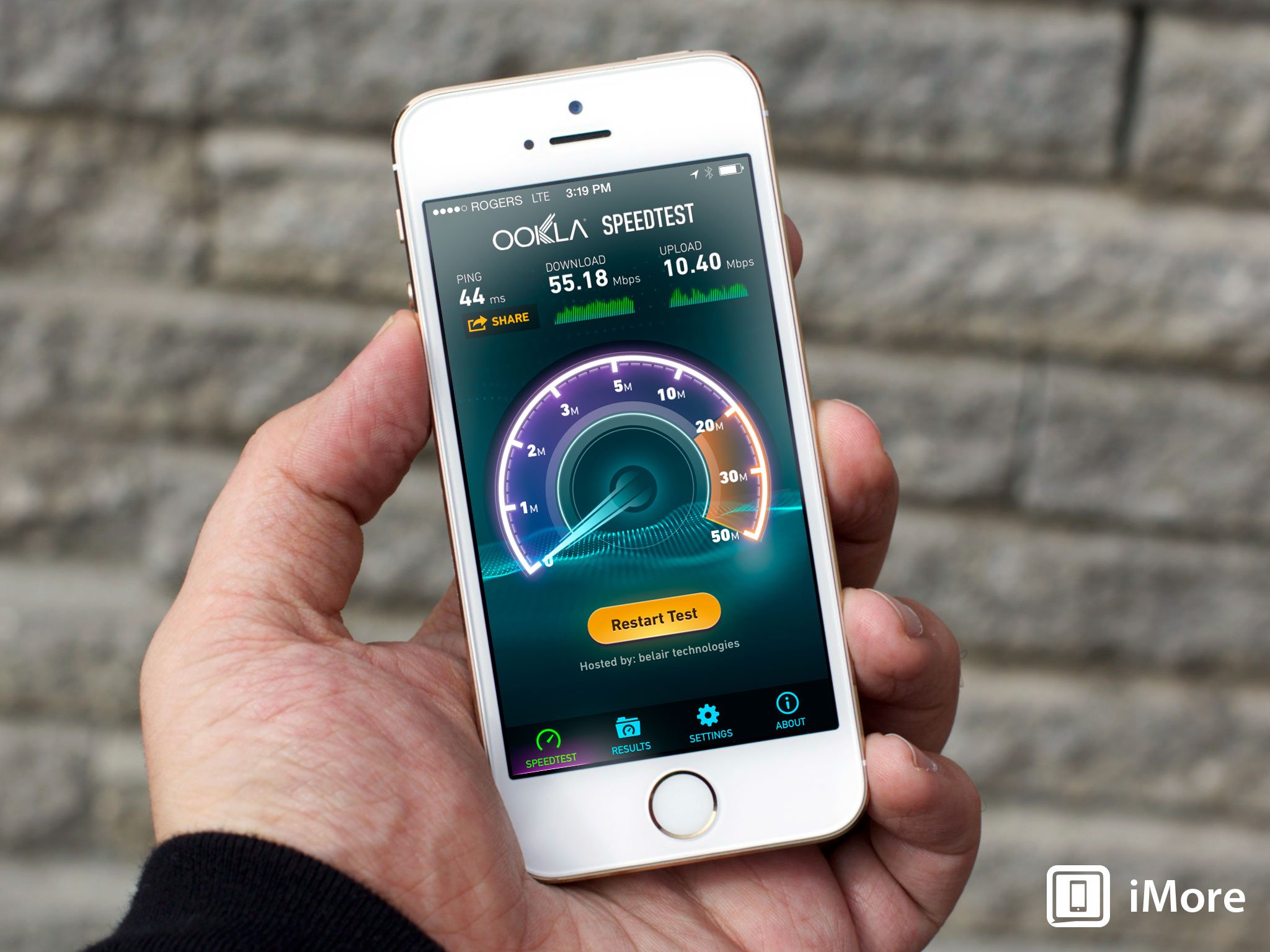
The iPhone 5 brought with it Long Term Evolution (LTE), a cellular networking technology so fast it rivaled many home broadband connections. It was a long time coming, Apple not one to jump on the early, power hungry, battery destroying chipset bandwagons. Their implementation was a pretty good one too, including 3 models, one compatible with CDMA in the U.S. This year, Apple is once again staying conservative in the radio space, not yet embracing LTE Advanced, or Voice over LTE (VoLTE) - though most carriers haven't yet embraced them either - but increasing the overall quantity of LTE bands they support. To do it, Apple's shipping 5 models of iPhone 5s:
- A1533 (GSM): UMTS/HSPA+/DC-HSDPA (850, 900, 1700/2100, 1900, 2100 MHz); GSM/EDGE (850, 900, 1800, 1900 MHz); LTE (Bands 1, 2, 3, 4, 5, 8, 13, 17, 19, 20, 25)
- A1533 (CDMA): CDMA EV-DO Rev. A and Rev. B (800, 1700/2100, 1900, 2100 MHz); UMTS/HSPA+/DC-HSDPA (850, 900, 1700/2100, 1900, 2100 MHz); GSM/EDGE (850, 900, 1800, 1900 MHz); LTE (Bands 1, 2, 3, 4, 5, 8, 13, 17, 19, 20, 25)
- A1453: CDMA EV-DO Rev. A and Rev. B (800, 1700/2100, 1900, 2100 MHz); UMTS/HSPA+/DC-HSDPA (850, 900, 1700/2100, 1900, 2100 MHz); GSM/EDGE (850, 900, 1800, 1900 MHz); LTE (Bands 1, 2, 3, 4, 5, 8, 13, 17, 18, 19, 20, 25, 26)
- A1457: UMTS/HSPA+/DC-HSDPA (850, 900, 1900, 2100 MHz); GSM/EDGE (850, 900, 1800, 1900 MHz); LTE (Bands 1, 2, 3, 5, 7, 8, 20)
- A1530: UMTS/HSPA+/DC-HSDPA (850, 900, 1900, 2100 MHz); GSM/EDGE (850, 900, 1800, 1900 MHz); FDD-LTE (Bands 1, 2, 3, 5, 7, 8, 20); TD-LTE (Bands 38, 39, 40)
As with the iPhone 5 and iPhone 5c, however, the bands are not enough. Apple won't enable a carrier for LTE unless they have a deal in place. That means an unlocked iPhone 5s can still only be used on a carrier that already offers the iPhone 5s.
Apple keeps an updated list of the countries and carriers with official iPhone 5s LTE support.
Ally Kazmucha tested the iPhone 5s on AT&T in the Indiana, and I tested it on Rogers in Montreal. Since it's using pretty much the same generation of LTE as the iPhone 5, results on SpeedTest.net are similar, though upload is better on some carriers. On AT&T, from left to right, iPhone 5s, iPhone 5c, and iPhone 5.
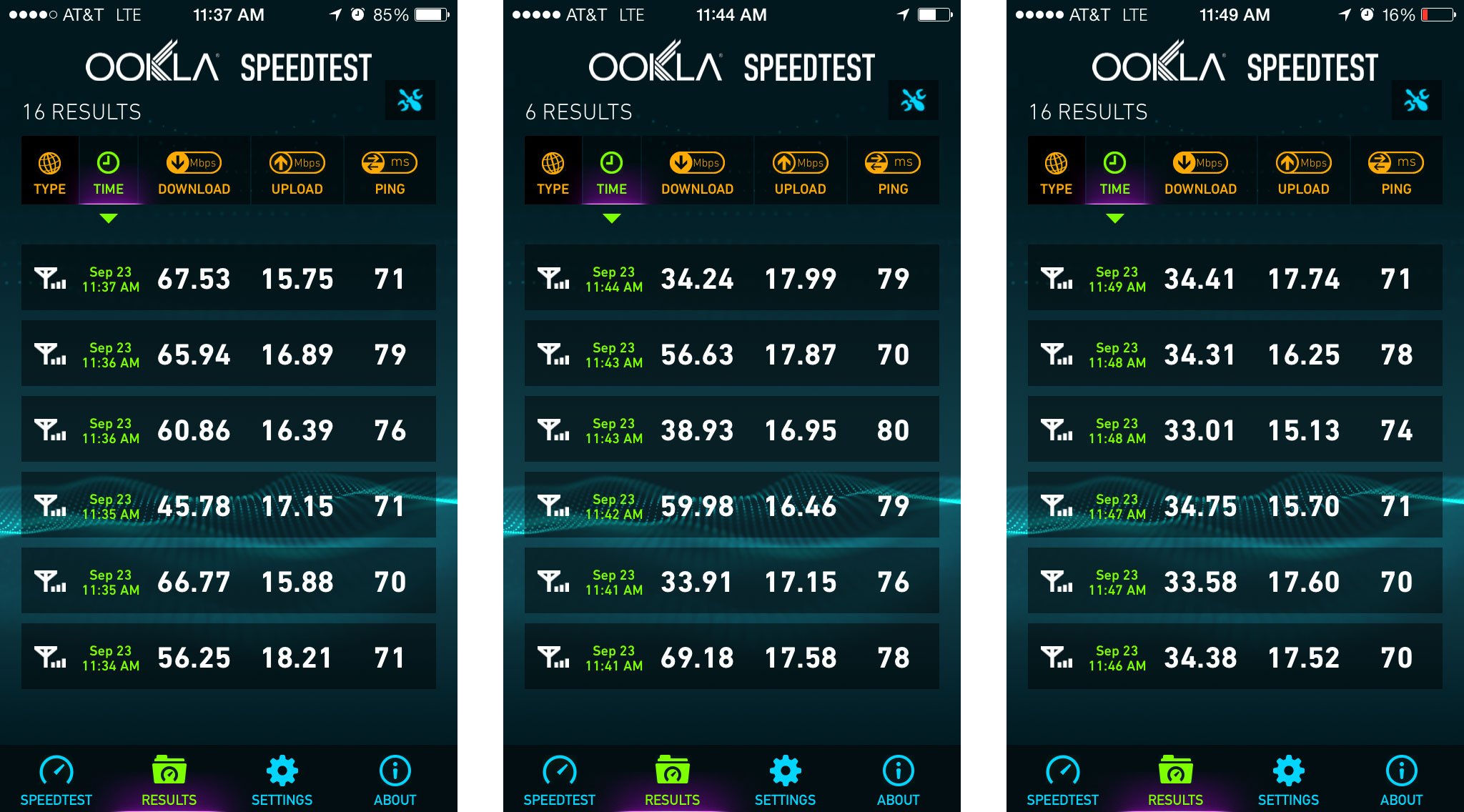
On Rogers, from left to right, iPhone 5s, iPhone 5c, and iPhone 5.
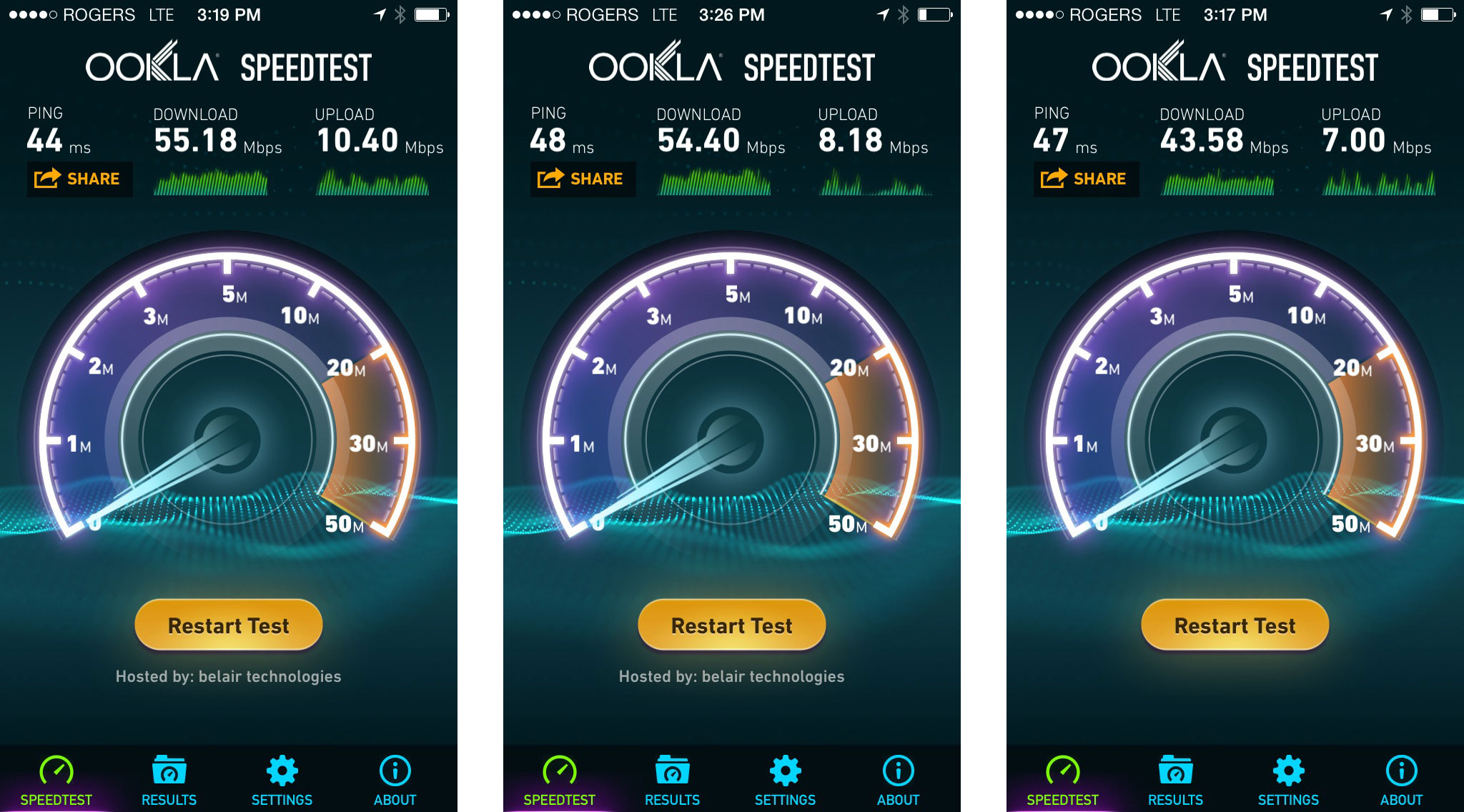
Ally found that the iPhone 5s was slightly more reliable when it came to holding an LTE than the iPhone 5. I found that to be true as well. It would get onto LTE faster, when available, and in some places stayed fine on LTE when the iPhone 5 seemed stuck on 3G.
For people in places where the iPhone 5 didn't support LTE, but the new bands on the iPhone 5s do, then the difference will be far more pronounced - you'll now get LTE where before you got none.
However, the old caveats remain true. LTE still doesn't support simultaneous voice and data, and Apple still chooses not to sacrifice battery life and sully their architecture just to open a second radio channel for Verizon and Sprint in the U.S. That means, just like with the iPhone 5, GSM carriers like AT&T and T-Mobile in the U.S., and most carriers around the world, will drop data to the still fast HSPA+ when you're on a call, and Verizon and Sprint, which don't support HSPA+ and whose legacy EVDO Rev. A networks also don't support simultaneous voice and data, will simply drop data entirely. (Wi-Fi will still work fine.)
Given that Apple included new, faster, better 802.11ac Wi-Fi not only in the 2013 MacBook Air but also in their new AirPort routers and Time Capsules, I was hoping they'd see fit to include it in the iPhone 5s as well. No such luck.
Despite the advancements of the Lightning cable, the NAND flash storage in the iPhone still tops out well before USB3 speeds, meaning tethered connections aren't getting any faster any time soon. (iOS devices don't use PCI architecture so can't use the much faster Thunderbolt connector Apple ships on Macs.) That leaves Wi-Fi. Both for transferring larger files, and for race-to-sleep (powering down quickly to save battery life), 802.11ac makes a lot of sense on mobile, and Apple's competitors are already pushing ahead with it. Unlike on OS X, however, where Apple's quick to support new networking technologies, the iPhone only just got 802.11n over 5GHz last year, so it appears Apple's conservative radio tendencies extend to Wi-Fi as well.
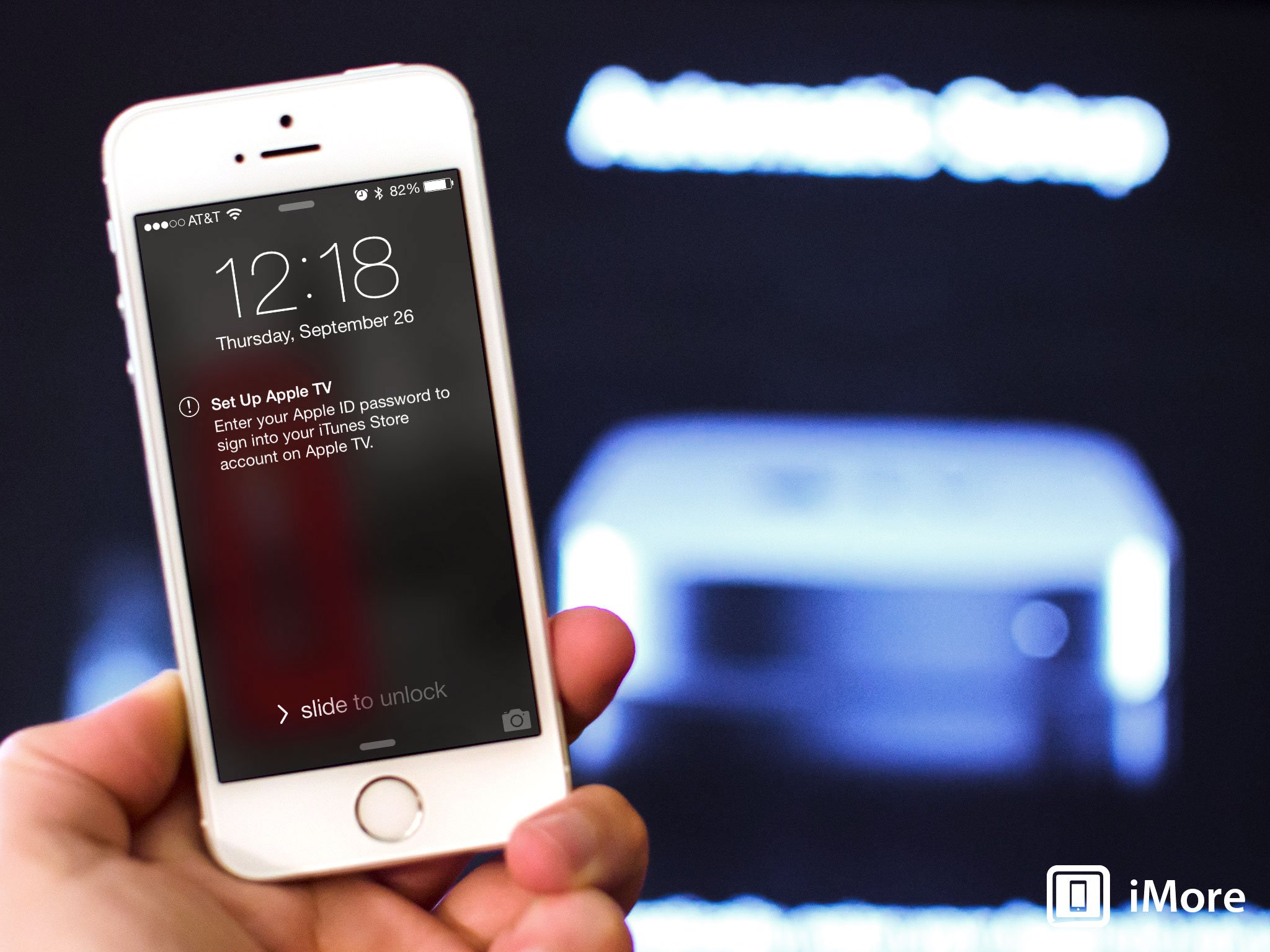
Bluetooth didn't get an update either, but in this case it's understandable. Eschewing their usual conservatism, Apple introduced Bluetooth 4.0 Low-Energy (LE)) way back in 2011 with the iPhone 4S. And it;s is still best in class. However, BT LE peripherals have come a long way in the last couple of years. Now, you can tap-to-setup an Apple TV, and in the near-future, work with iBeacons for everything from indoor navigation to guided tours, commerce, and more.
iPhone 5s and iOS 7
The iPhone 5s ships with iOS 7, the latest generation of Apple's UNIX-based mobile operating system. While it's clearly not matched to the palette the way the iPhone 5c was, but there's still plenty of cosmetic fun to be had. Sadly, none of the new dynamic wallpapers are exactly the right hue, saturation, or balance for the silver, gold, or space gray iPhones. Since no one but Apple can generate dynamic wallpapers yet, it would have been nice to get a proper set of those included. The still wallpapers, however, include several new selections that pair fantastically well.
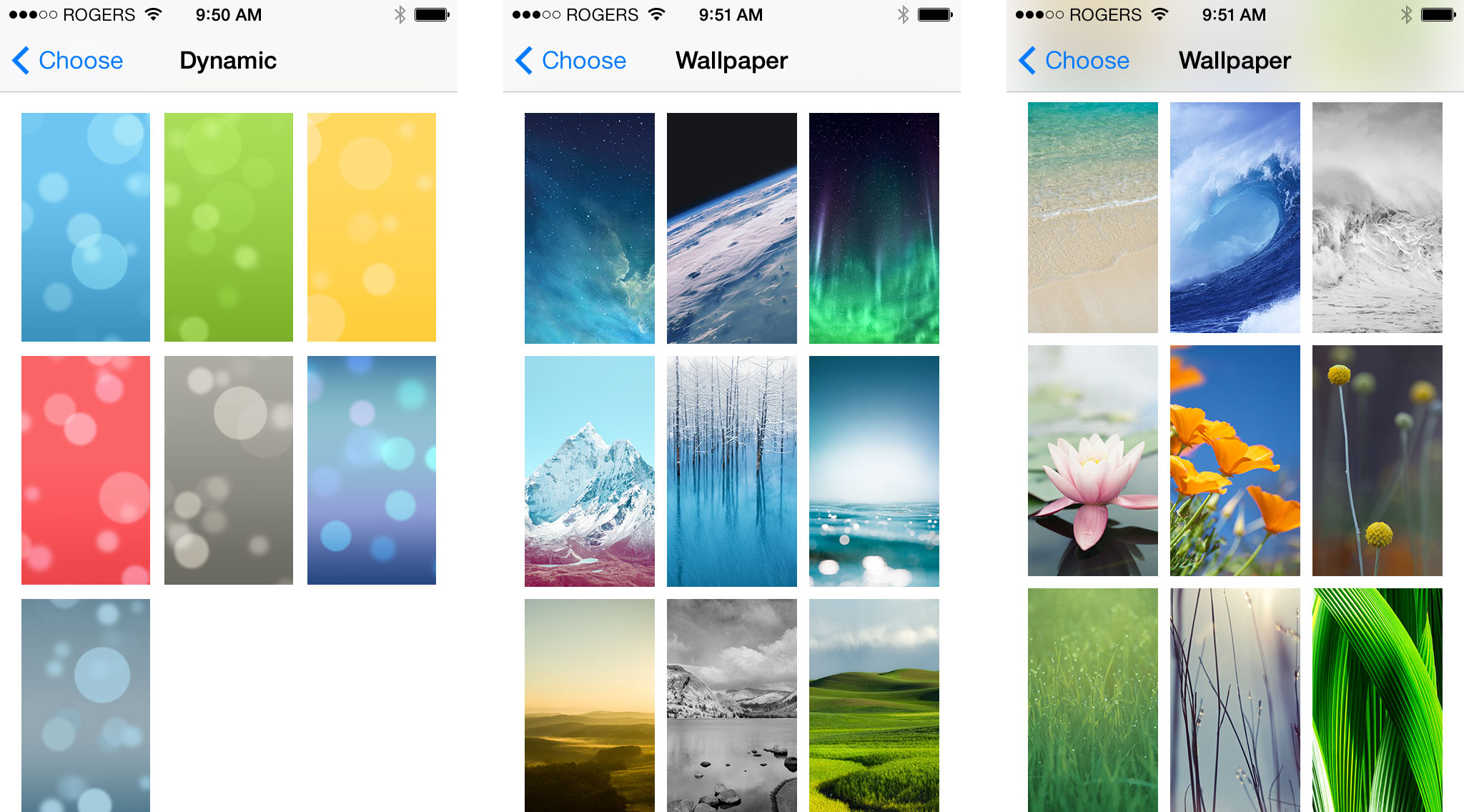
In addition to all the new featured tied to the Apple A7, M7, Touch ID, and iSight camera, covered above, iOS 7 includes a complete interface and experience redesign, based in part on a new physics and particle engine, layers of blur and transparency, and starker, more mature text, icons, and control. There are also new services for Siri, a new Today screen for Notification Center, and an entirely new Control Center that allows quick access to Settings toggles, media controls, LED-flash based flashlight, calculator, timer, and camera.
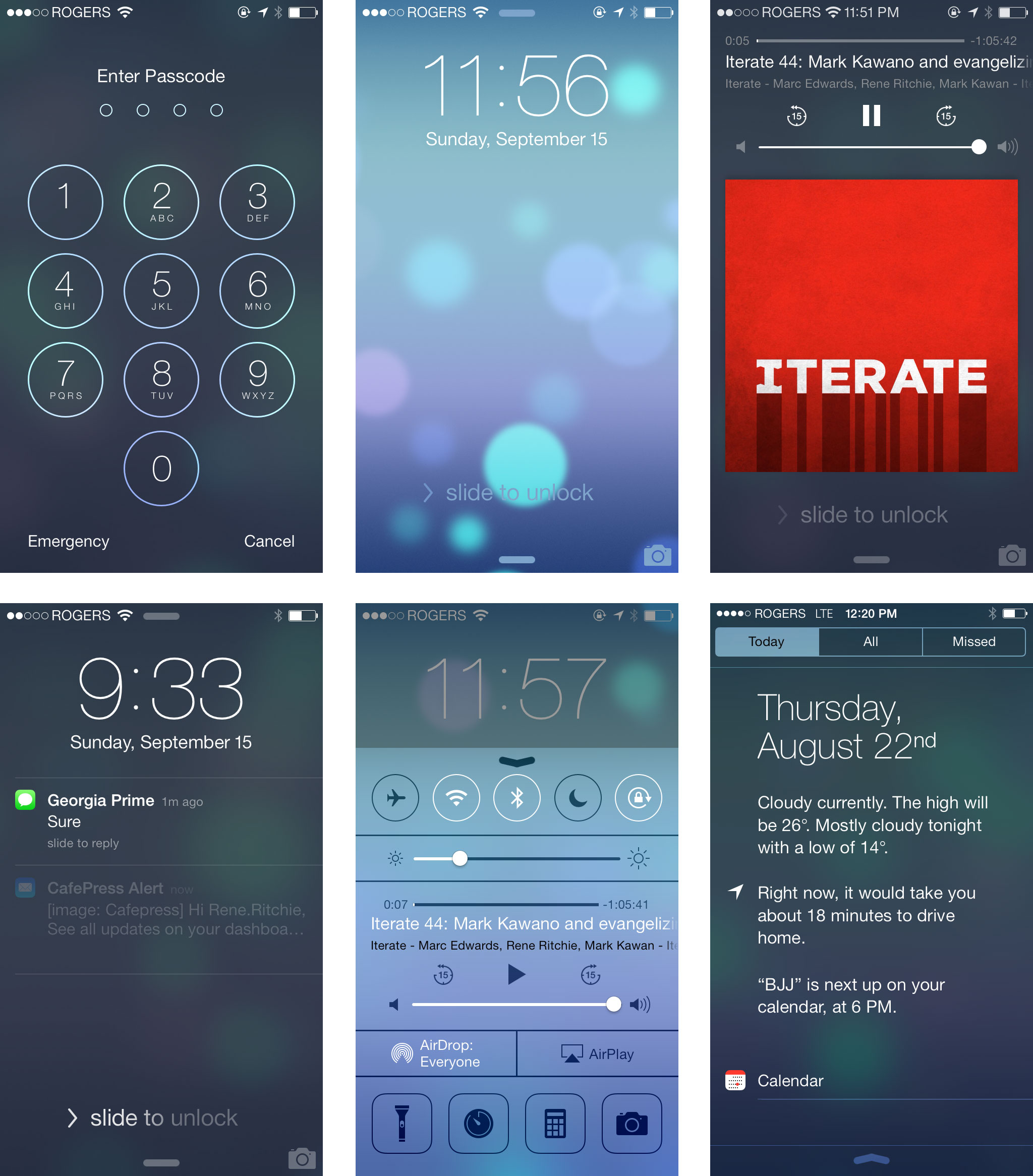
Multitasking has been significantly improved, with a new card-based visualization and just-in-time background access for every app, and AirDrop, while not yet compatible with the OS X feature of the same name, lets you easily share items over peer-to-peer Wi-Fi. Safari is redesigned as well, with a new rolodex interface for tabs, a much cleaner browsing experience, and smarter bookmarks, including the ability to pull all the links from your Twitter feed.
FaceTime audio could do for voice calls what iMessage did for SMS - allow us to communicate without the huge carrier bills that sometimes come with it. And a along with the many new conveniences, there are also a host of new security features to go with them.
For an in depth look at all of that, and more, check out our full iOS 7 review.
iPhone 5s and apps
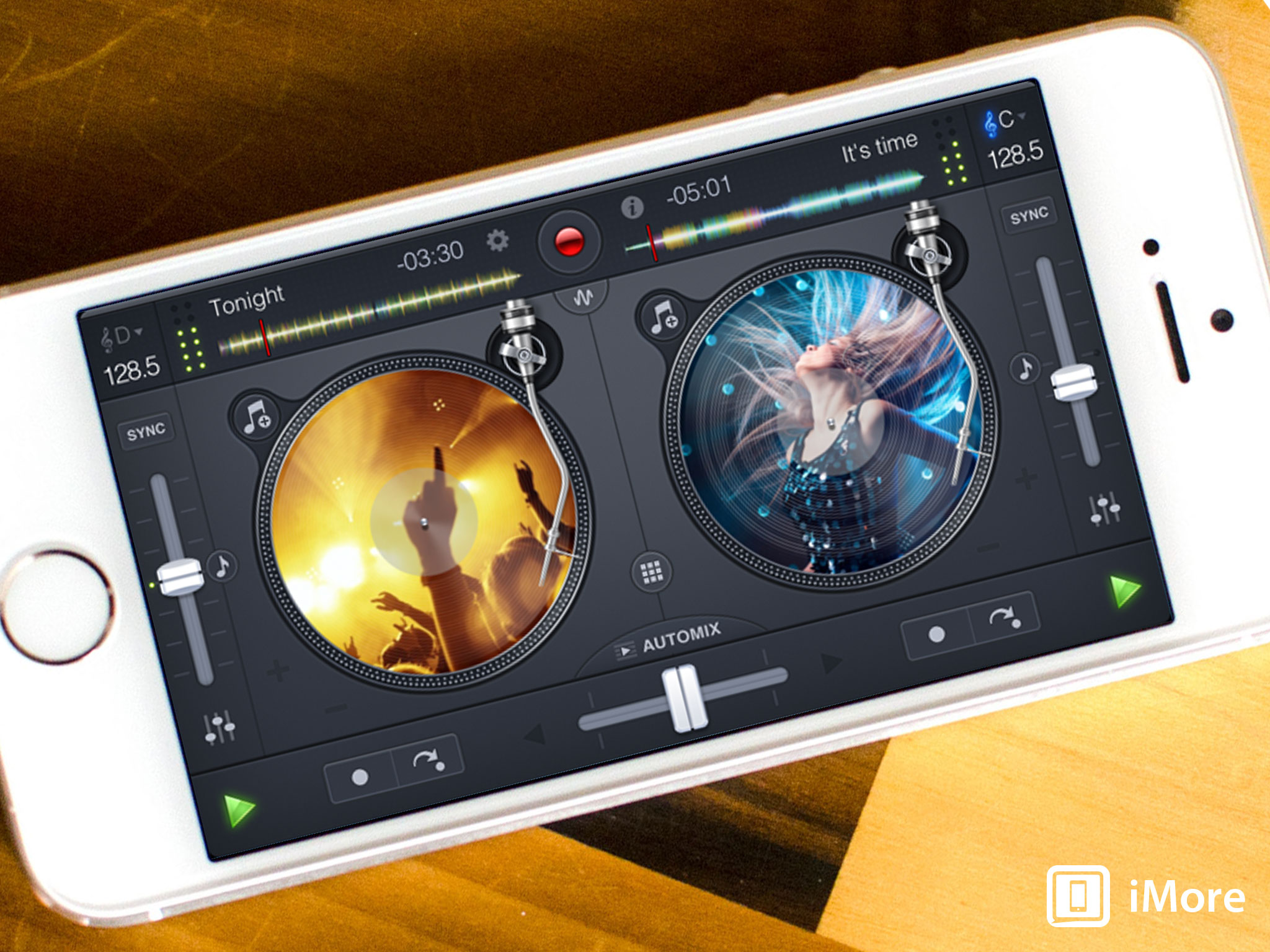
The iPhone 5s ships with over a score of built-in apps, including Messages, Calendar, Photos, Camera, Weather, Clock, Maps, Videos, Notes, Reminders, Stocks, Game Center, Newsstand, iTunes Store, App Store, Passbook, Compass, Settings, Contacts, Calculator, Voice Memos, and FaceTime. Apple also provides numerous free apps on the App Store, including iBooks, Podcasts, iTunes U, Find my iPhone, Find my Friends, Apple Store, Remote, Trailers, AirPort Utility, and the now free-with-a-new-device iLife and iWork suites of iMovie and iPhoto (GarageBand remains at $4.99), and Keynote, Pages, and Numbers.
Google provides a set of great, free apps for their most popular services as well, including Google Search (with Google Now), Google Maps, Google+, Gmail, Google Drive, YouTube, Google Voice, Hangouts, Chrome, and many, many more. Same with Microsoft with Bing, SkyDrive, PhotoSynth, Office Mobile for Office 365, Kinectimals, and more. Amazon, Facebook, Twitter, and pretty much everyone you can think of are on the App Store as well. Even BlackBerry Messenger (BBM) is coming soon. No other platform enjoys as wide ranging app support.
There are also hundreds of thousands of iPhone apps available, and the iPhone 5s is compatible with all of them, including ones that take specific advantage of 64-bit, OpenGL 3.0, and the M7 motion co-processor. Since the iPhone 5s just launched, there aren't too many iPhone 5s-specific apps yet, but that'll change quickly, and there could be other, additional advantages over the coming weeks and months.
iPhone 5s services and support
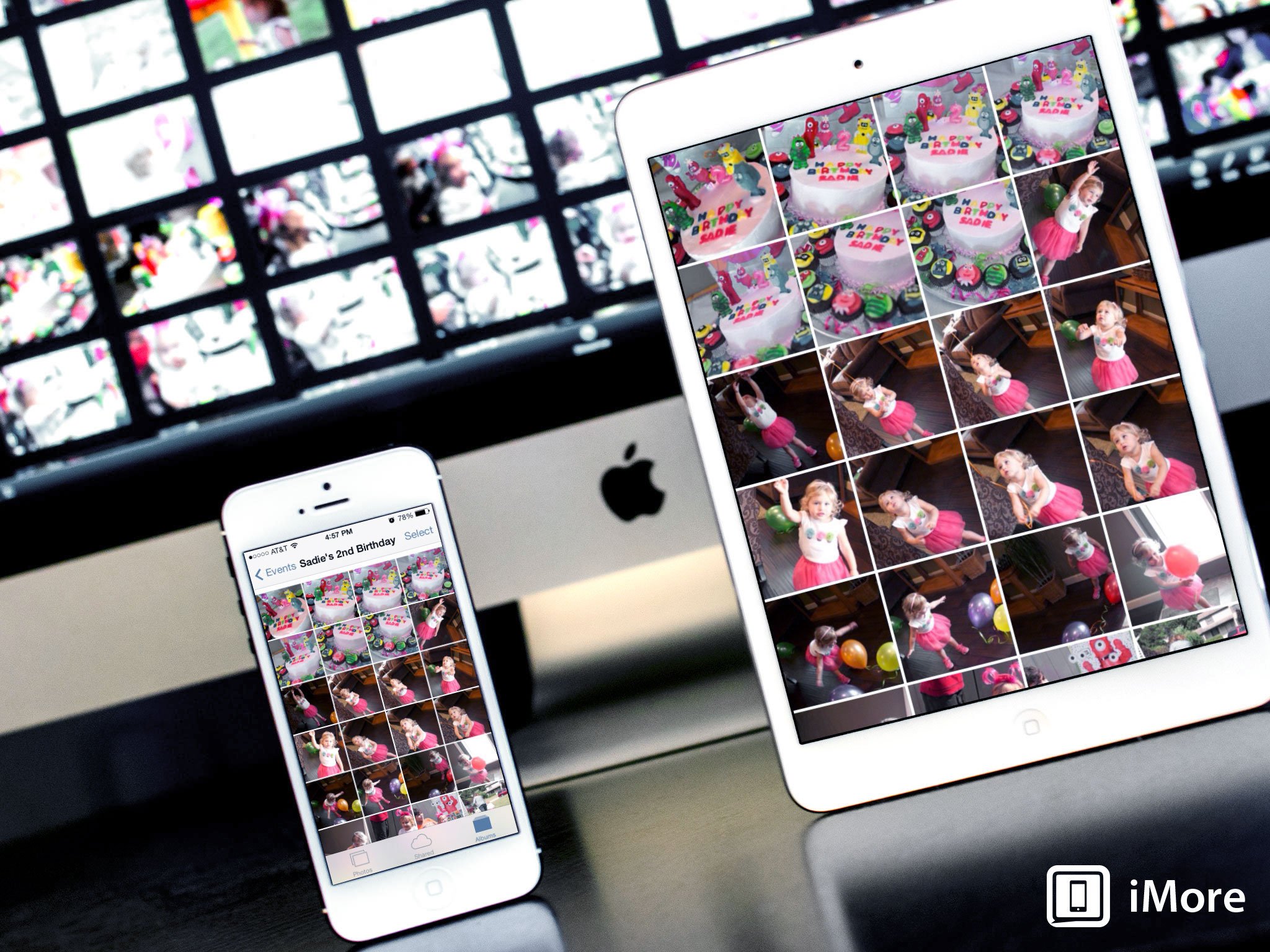
iCloud comes free with every Apple device. On the iPhone 5s it lets you wireless backup your data to Apple's servers, and wirelessly restore it if you ever need to re-install iOS or you switch devices. iCloud also lets you re-download anything you've bought on iTunes, the App Store, or the iBookstore, including music, movies, TV shows, apps, games, and iBooks. Photo Stream keeps recent photos both safe and ubiquitously available, as does Documents in the Cloud with files, and there's even an online version of the iWork suite coming soon to iCloud. There's a free version of the currently U.S.-only iTunes Radio service, as well as the paid iTunes Match music locker service. If you want additional iCloud storage, it's expensive but you can buy it.
Apple Stores, especially when combined with iCloud, whether extended by AppleCare+ or not, provide remarkable customer support for iPhone 5s owners. Apple specialists can help you test a phone to make sure it's what you want, help you set it up, teach you how to use it, and if anything goes wrong, help you fix it. It's a feature not always included on competitive checklists but anyone who's ever needed to avail themselves of it knows just how important a feature it is.
iPhone 5s and accessories
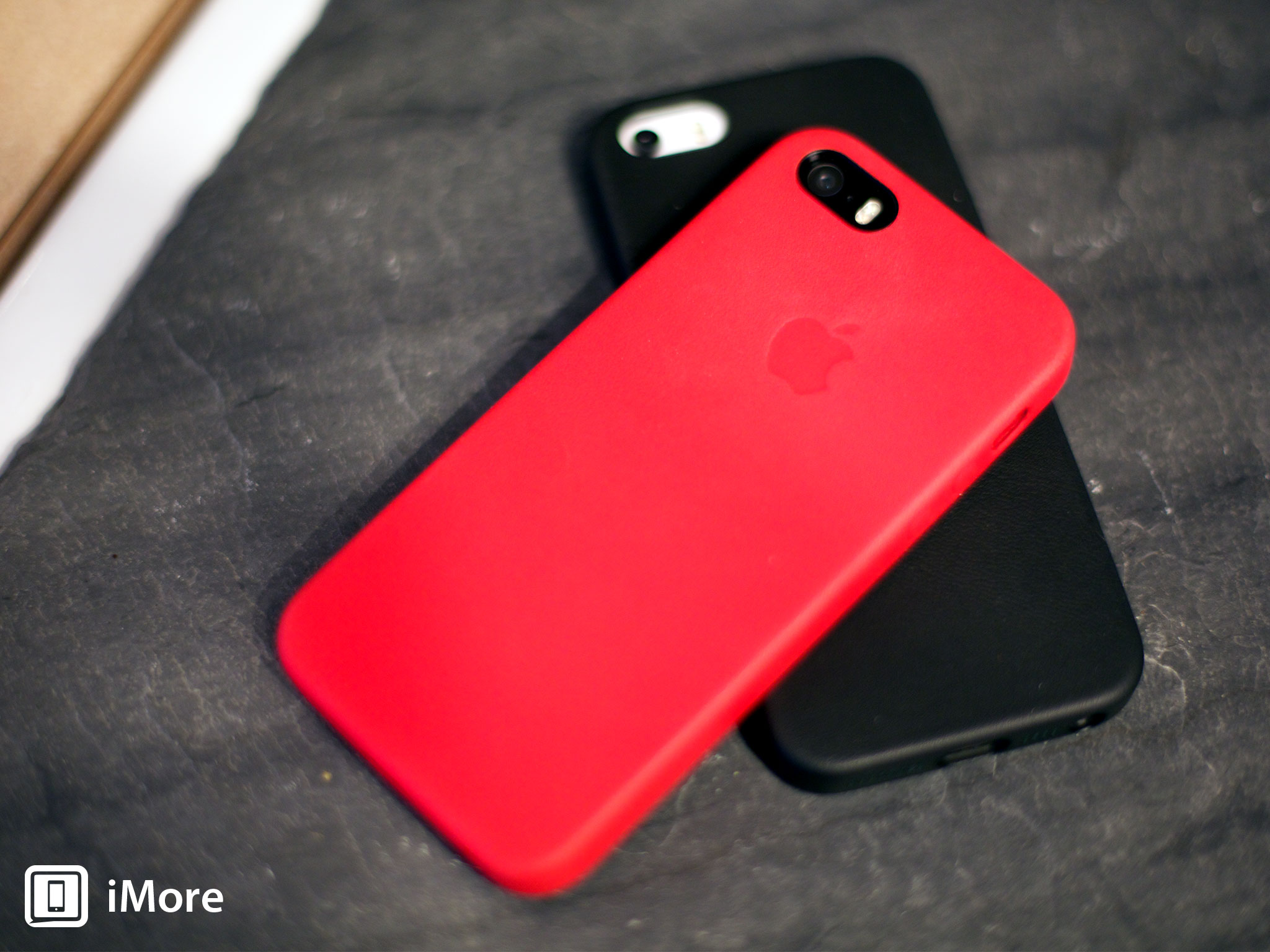
Thanks to its nearly identical casing, the iPhone 5s is broadly compatible with existing iPhone 5 cases with the exception of those that obstruct the Touch ID lens (i.e. cover it with non-capacitive, non-transparent material). That's if you use Touch ID. Otherwise, your choice should be close to limitless.
Apple has also decided to launch their own iPhone 5s case. Nowhere nearly as colorful as the iPhone 5c cases, they come in yellow, sickly beige, pale blue, golden brown, black, and (RED). That (RED) benefits the Product (RED) charity and is exclusive to Apple stores. Made out of leather, the texture is visible but fine, adding depth to the sheen, and providing more warmth and grip than the cold metal and glass of the iPhone 5s proper allows. They're also solid, have a microfiber interior, and a lip that rises up above the screen to better protect your iPhone's finish back and front. The headphone cutout might be a bit tight, and the volume and sleep/wake covers are way too squishy for some tastes.
- $39 - Buy now
There's also a dock. White. Plastic. Charges over Lightning cable. In other worlds, the archetypal iPhone dock.
- $29 - Buy now
Because the iPhone 5s fits almost all the iPhone 5 cases and docks ever made, however, there's an incredible amount of choice and you should definitely look around before settling on Apple's. All other accessories, from charges to Bluetooth, car kits to toys, cables to adapters, protective films to stylus pens, should also all work fine with the iPhone 5c, include, of course, the Apple TV.
iPhone 5s pricing and availability
The iPhone 5c comes in three capacities, 16GB, 32GB, and 64GB. On contract, with full subsidy, they'll typically run you $199, $299, and $399 in the U.S. Off contract, full price, that's $649, $749, and $849.
Although Apple is currently selling them faster than they can produce them, the iPhone 5s is theoretically available in the U.S., Australia, Canada, China, France, Germany, Hong Kong, Japan, Puerto Rico, Singapore and the U.K. from Apple, carriers, and authorized resellers. Additional countries and carriers will launch in the coming weeks and months.
iPhone 5s buyers guide
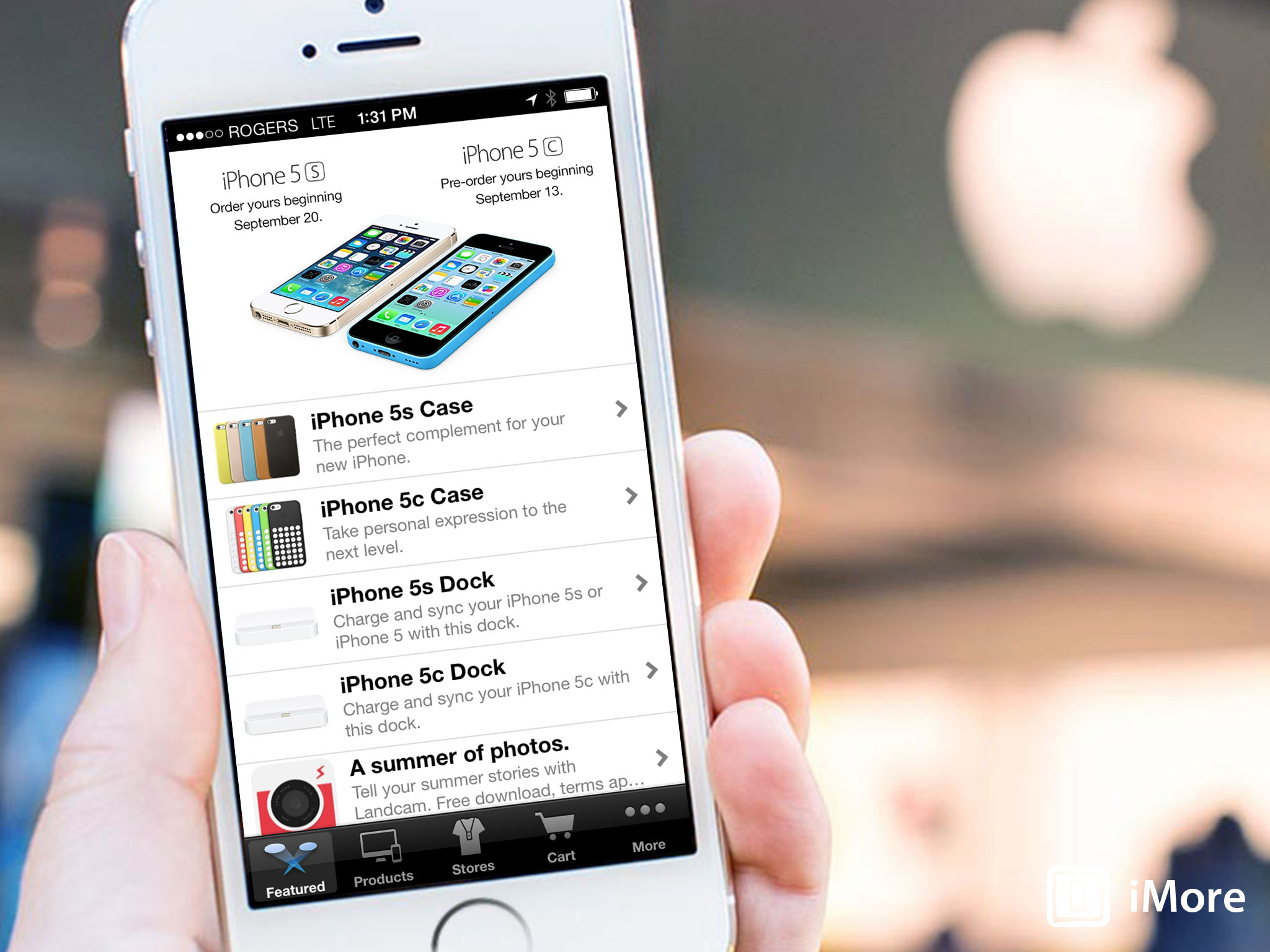
The iPhone isn't the only great phone on the market anymore. It might be one of the best, and still my default recommendation for the vast majority of people, but that still leaves a lot of room for a lot of other people. Should the iPhone 5s be your first leap into smartphones? Into phones? Are there alternatives from Samsung, Motorola, HTC, Nokia/Microsoft, or BlackBerry you might want to consider instead? If you have an iPhone already, should you upgrade? From an iPhone 3GS or iPhone 4? From an iPhone 4s or iPhone 5? Should you consider the iPhone 5c instead?
If you do decide the iPhone 5s is the phone for you, what color should you get? What capacity and on which carrier? There a lot of factors to be weighed and decisions to be made. The 2013 iMore iPhone buyers guide can help:
If you have specific questions:
iPhone 5s bottom line
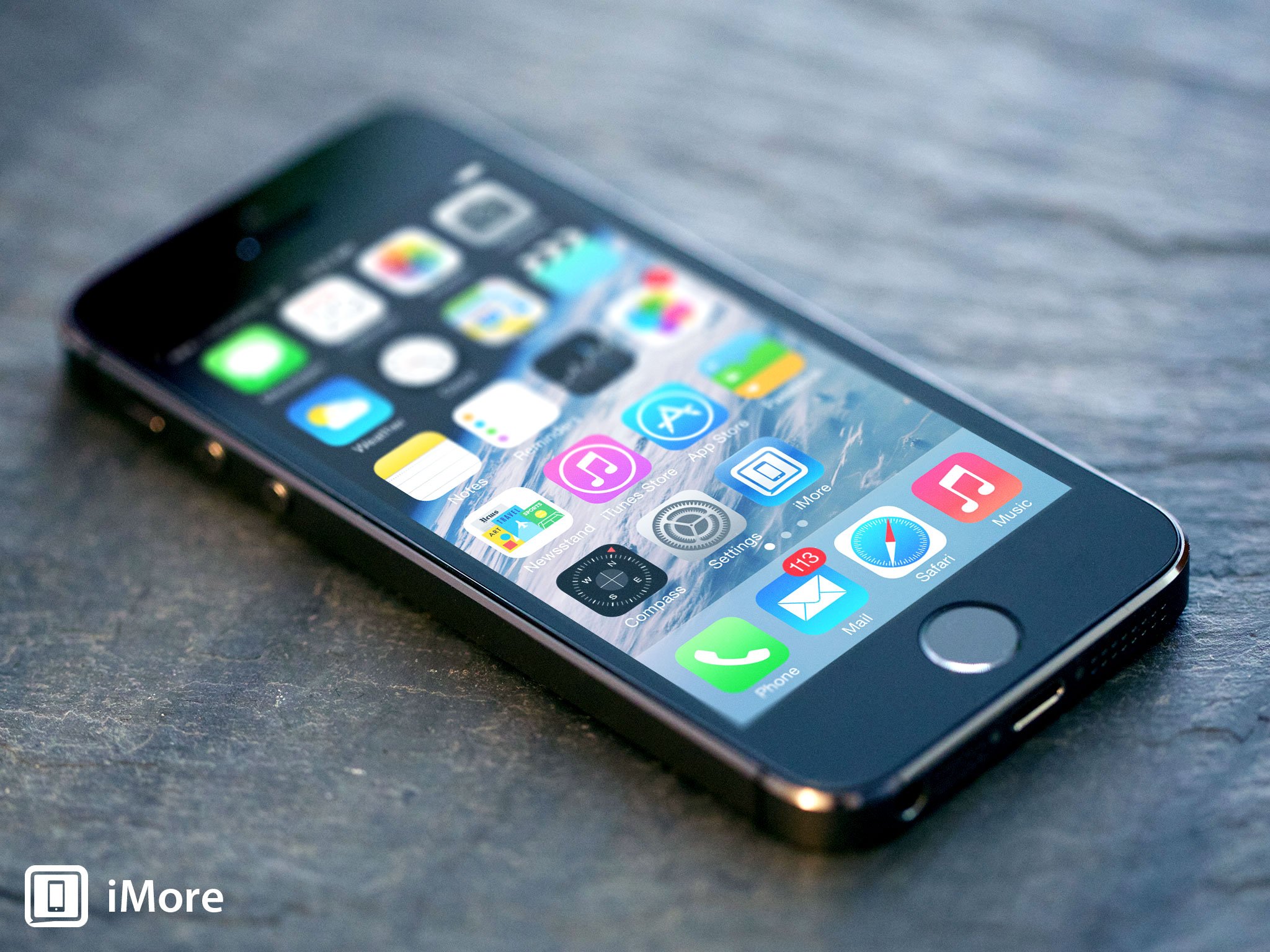
Apple calls the iPhone 5s the most forward-thinking iPhone ever. Tock to the iPhone 5 tick, like previous S-class updates, that promise of the future is counterbalanced by an incredible amount of performance, optics, and special new features delivered right here in the present. When the iPhone 3GS launched with VGA video, I enjoyed the clever implementation even as I wanted more. Now I have 1080p and 120fps slow-motion in the palm of my hand. When the iPhone 4S launched, I enjoyed using Siri even as I dreamt of JARVIS. Siri still has far to go, but every year since it's done more, and better. Now, with the iPhone 5s, I'm scratching in djay 2 and slashing in Infinity Blade III while imaging how far Apple can take 64-bit and OpenGL ES 3.0 on mobile and over AirPlay. And I'm buying them both with a fingerprint, even as I dream of everything else I'll eventually be able to buy with biometrics, and soon.
The iPhone 5 was a fantastic upgrade that never got the recognition it deserved. iPhone 5s builds on that foundation, and thanks to both iOS 7 on the inside and some gilding on the outside, perception is better reflecting reality than it has in years. It doesn't have the 41-megapixel lens of the Lumia 1020, the physical keyboard of the BlackBerry Q10, the double-sized battery of the Motorola MAXX variants, or the 5-inch screen of the Samsung Galaxy S4. The iPhone 5s makes a lot of tradeoffs that, while good for most of the people most of the time, won't be good for everyone, every time. That means there could be other phones by other manufacturers that better suit some needs. There may even be another phone by Apple.
The iPhone 5c is Apple's other new iPhone this year, and it's positioned as a mid-tear, brightly colored, pop-art alternative. It's a great phone. It's a fun phone. And it's also a phone that frees Apple up to really push the pedal to the even-more-premium metal with iPhone 5s. Having a safety means they will ultimately be able to push more boundaries.
Sure, some will be swayed to the iPhone 5c. Others will hold out for the promise of a bigger screened iPhone 6 next year. But if you want iOS, along with top-of-the-line performance, optics that are among the best-in-class, and want to literally reach out and touch the future, now, today - you'll get the iPhone 5s.
Ally Kazmucha, Richard Devine, Peter Cohen, Georgia, Anthony, Joe Keller, and Nick Arnott contributed photography, videography, research, testing, and/or large amounts of time and effort to this review.

Rene Ritchie is one of the most respected Apple analysts in the business, reaching a combined audience of over 40 million readers a month. His YouTube channel, Vector, has over 90 thousand subscribers and 14 million views and his podcasts, including Debug, have been downloaded over 20 million times. He also regularly co-hosts MacBreak Weekly for the TWiT network and co-hosted CES Live! and Talk Mobile. Based in Montreal, Rene is a former director of product marketing, web developer, and graphic designer. He's authored several books and appeared on numerous television and radio segments to discuss Apple and the technology industry. When not working, he likes to cook, grapple, and spend time with his friends and family.
